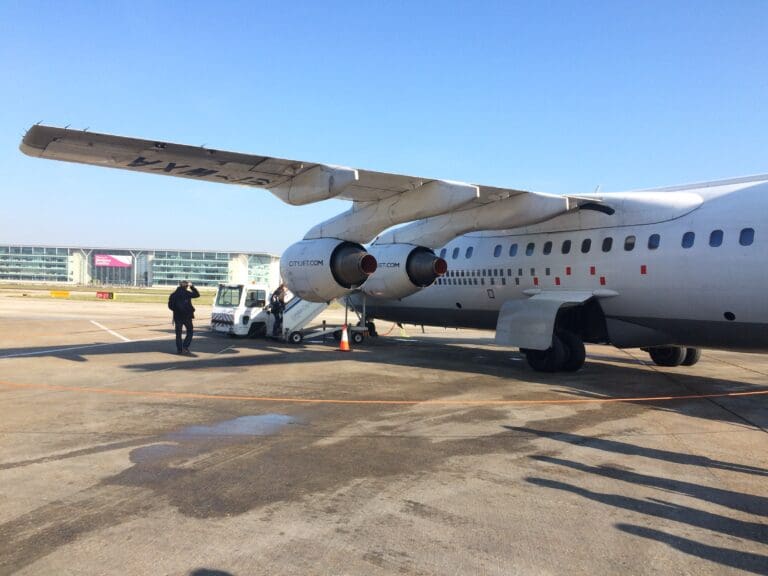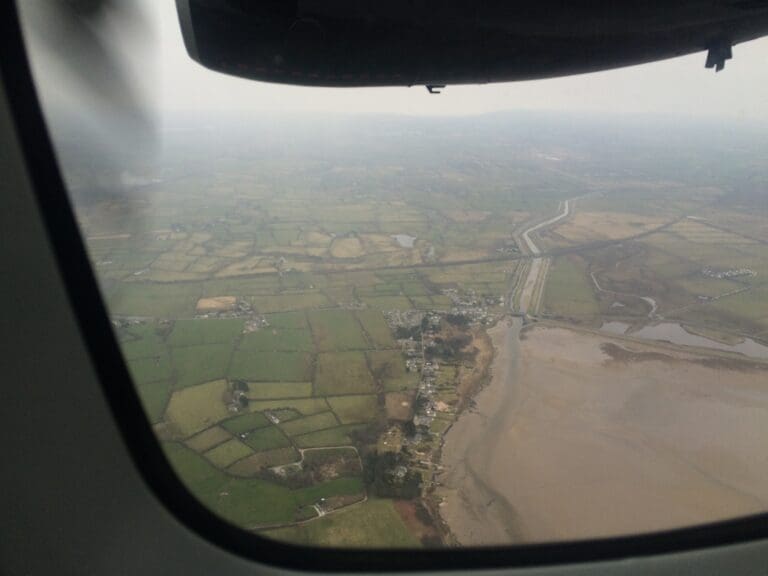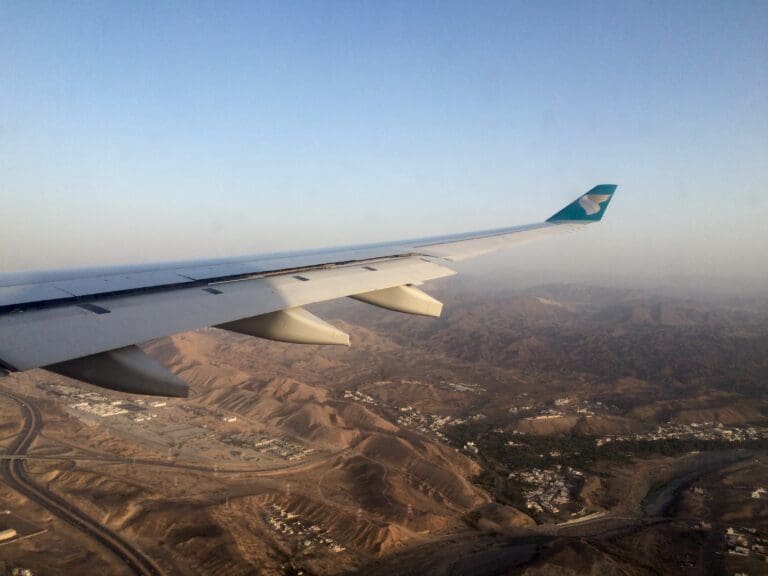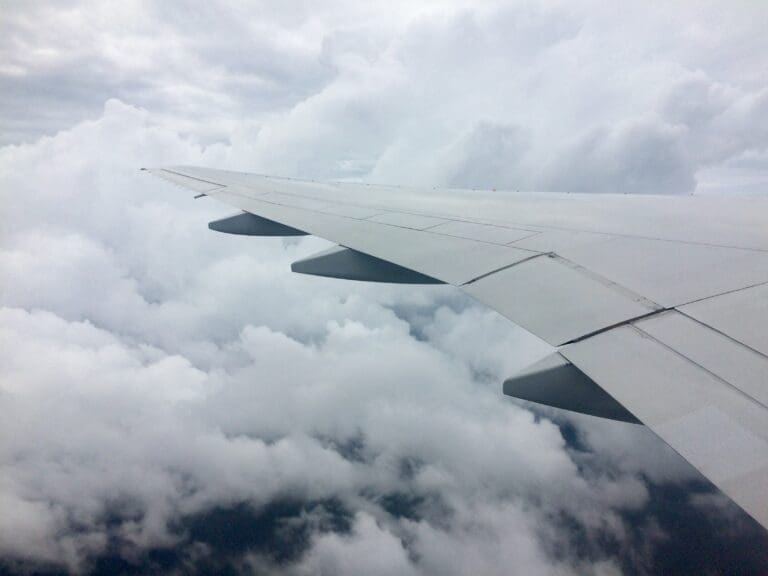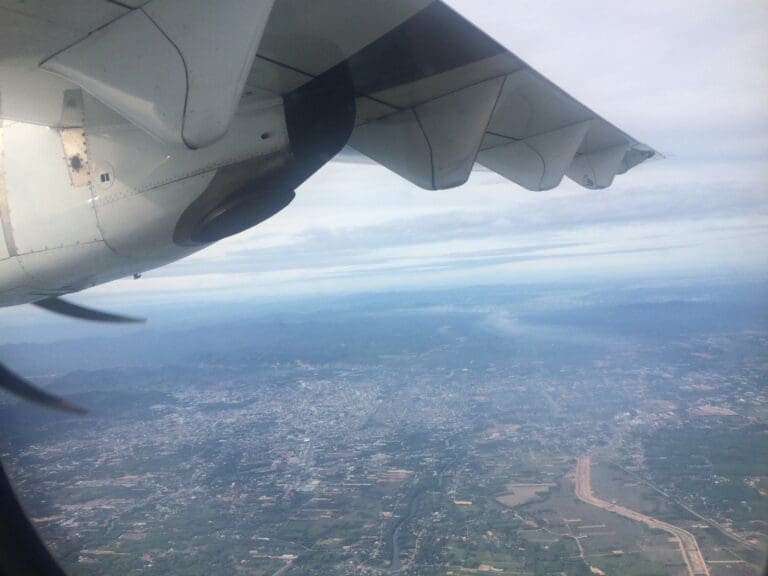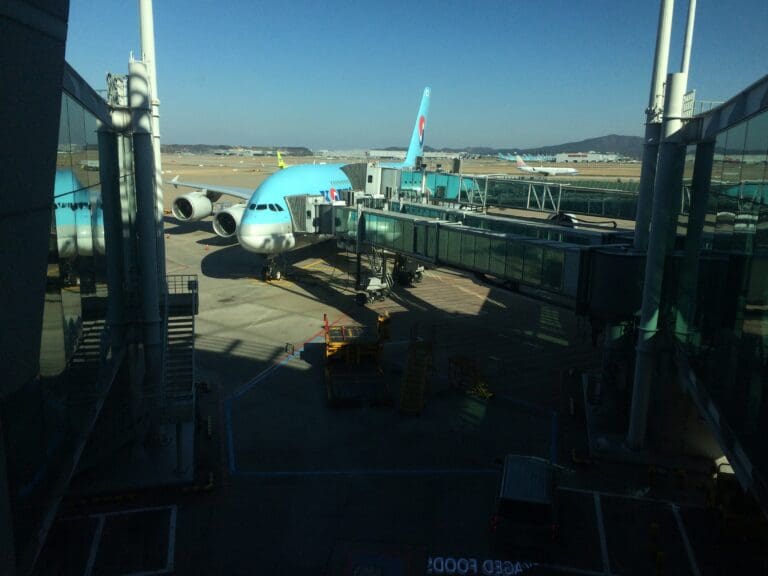Sampling AZAL’s Low-Cost Arm: Tbilisi to Baku on a Buta Airways Embraer 170
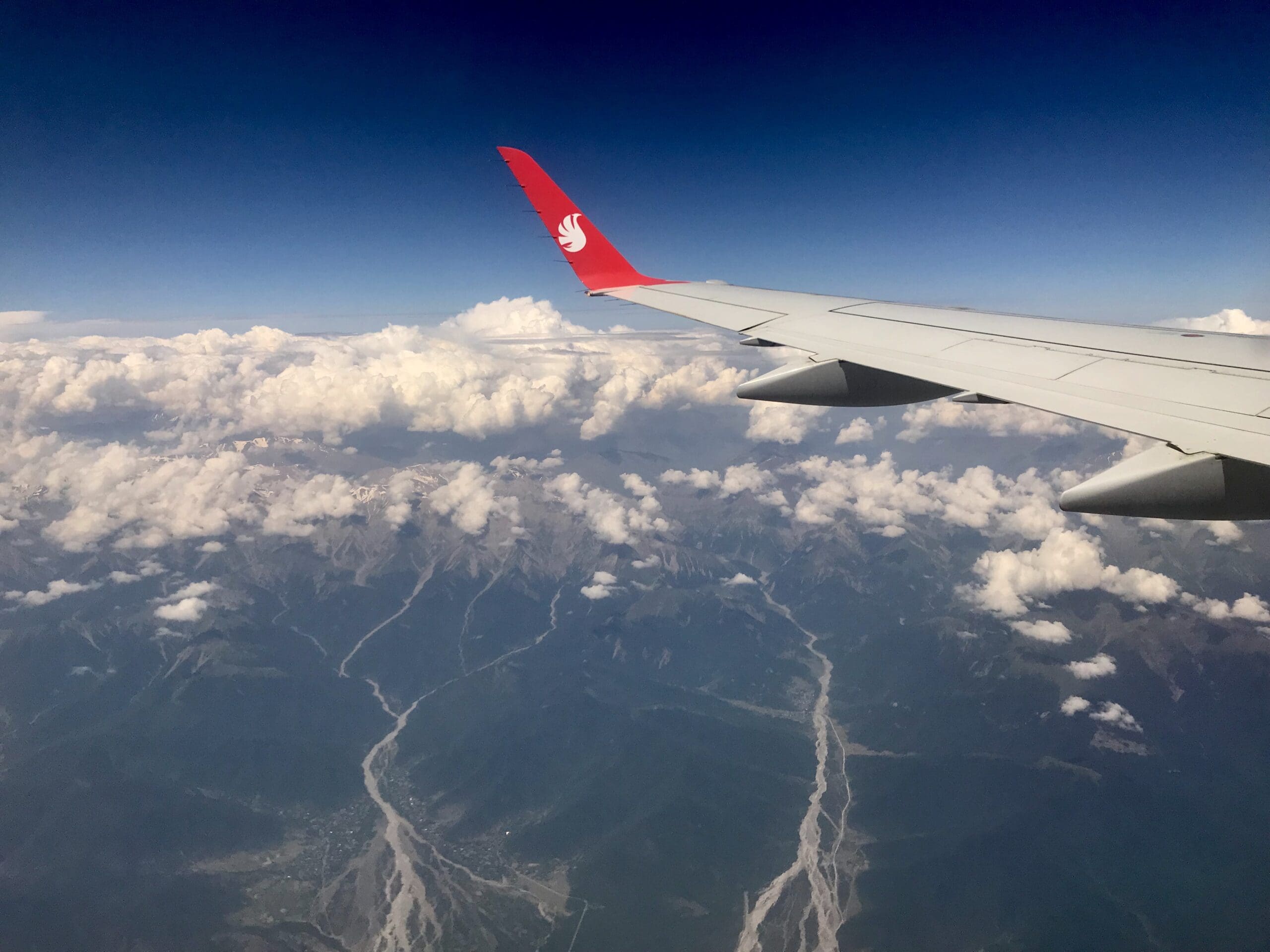
After an enjoyable week in Georgia with my father, it was time to return to the UK, via Azerbaijan and Ukraine. This slightly convoluted return route involved a Buta Airways E-Jet to Baku, where we would spend an afternoon and evening in Azerbaijan’s capital before flying to Kyiv Boryspil aboard an Azerbaijan Airlines Airbus A319. After several hours exploring central Kyiv, we would then return to the airport for an evening flight back to Gatwick with Ukraine International Airlines.
The Flight
On the morning of our departure, thanks to the network of buses running between Tbilisi and its airport, little planning was required to figure out how to reach the airport with plenty of time to spare before the flight. In addition to the buses and taxis, a newly opened rail link runs between the airport’s dedicated train station and Tbilisi’s main rail terminus. However, somewhat surprisingly, only two trains run in each direction per day, making this one of the less common methods of reaching the airport. Given the flight’s late morning departure and our obsession with punctuality, we opted to take one of these two daily trains, choosing the first departure at 07:50. With ample time to spare, at around 07:10 we left our rented apartment, where we had stayed for the previous three nights, and walked down one of the city’s many hills towards Rustaveli Station on the metro’s Akhmeteli-Varketili Line. Once we tapped in, we descended into the depths of the system’s deepest station before boarding a noisy Metrovagonmash Soviet-era metro train, the same type still used by many metro networks across the former Soviet Union.
Arriving at Station Square a couple of stops later, we headed back up to the surface and emerged at a line of kiosks leading to the main railway station’s entrance. Compared to other capital city railway termini, Tbilisi’s is relatively modest in style and much smaller. However, serving its purpose and being quiet at that time, we found little to complain about. Soon, we were at the ticket counter and, in a quick transaction, parted with just 1.00 Georgian Lari for two one-way tickets to the airport. After checking the departure boards, we headed to the platform and waited in the morning heat. With some time before 07:50, neither of us was concerned by the absence of a train at the platform or, for that matter, at the station. The presence of numerous travellers with large suitcases convinced us the train would soon arrive to whisk us off to the airport.
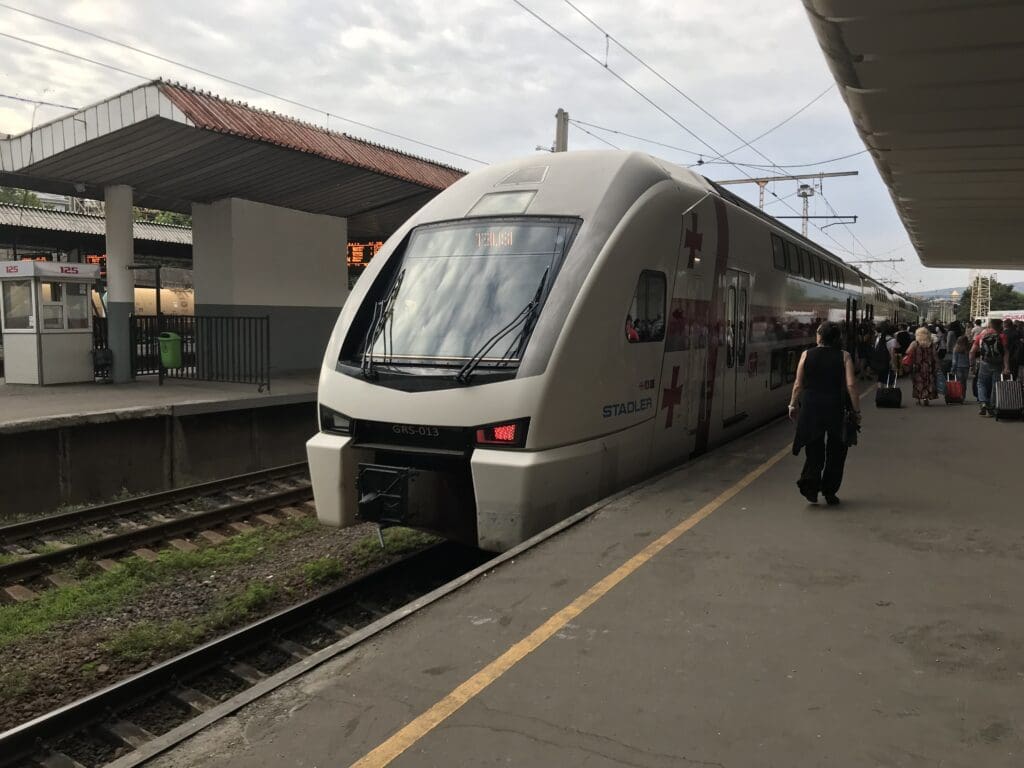
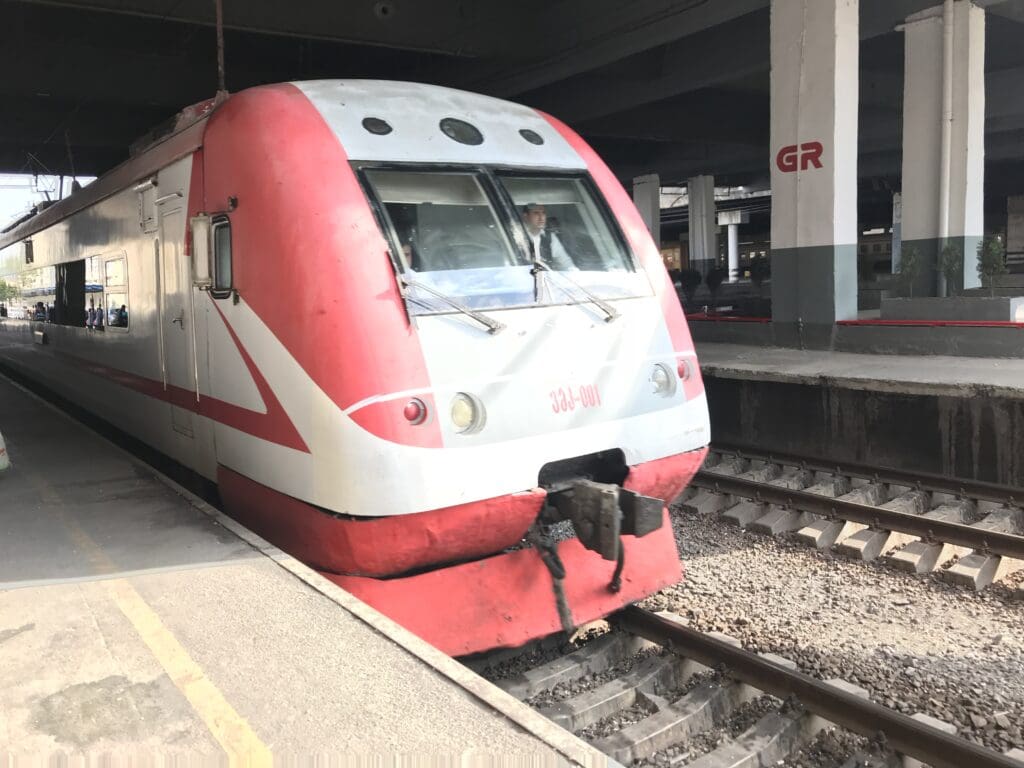
After about a ten-minute wait, a modern, shiny, and empty train pulled up at the station and opened its doors. Nearly everyone waiting on the platform scrambled to board, only to discover that this train wasn’t bound for the airport but was, instead, heading for Batumi. After double-checking with one of the attendants, we were advised to wait on the platform. The Batumi-bound train soon departed, leaving us with little choice but to wait. Forty minutes after the train’s scheduled departure time, our train disappeared from the departure boards, signalling that it wouldn’t be arriving anytime soon. We decided to leave the station and take a bus to the airport, thus forfeiting the small fee we had paid for the train tickets. Fortunately, there was a direct city bus connecting the station to the airport, making the journey relatively painless, though a little cramped. After a long ride across Tbilisi, the bus finally sped down the hill leading to the airport, and the modern glass terminal soon came into view.
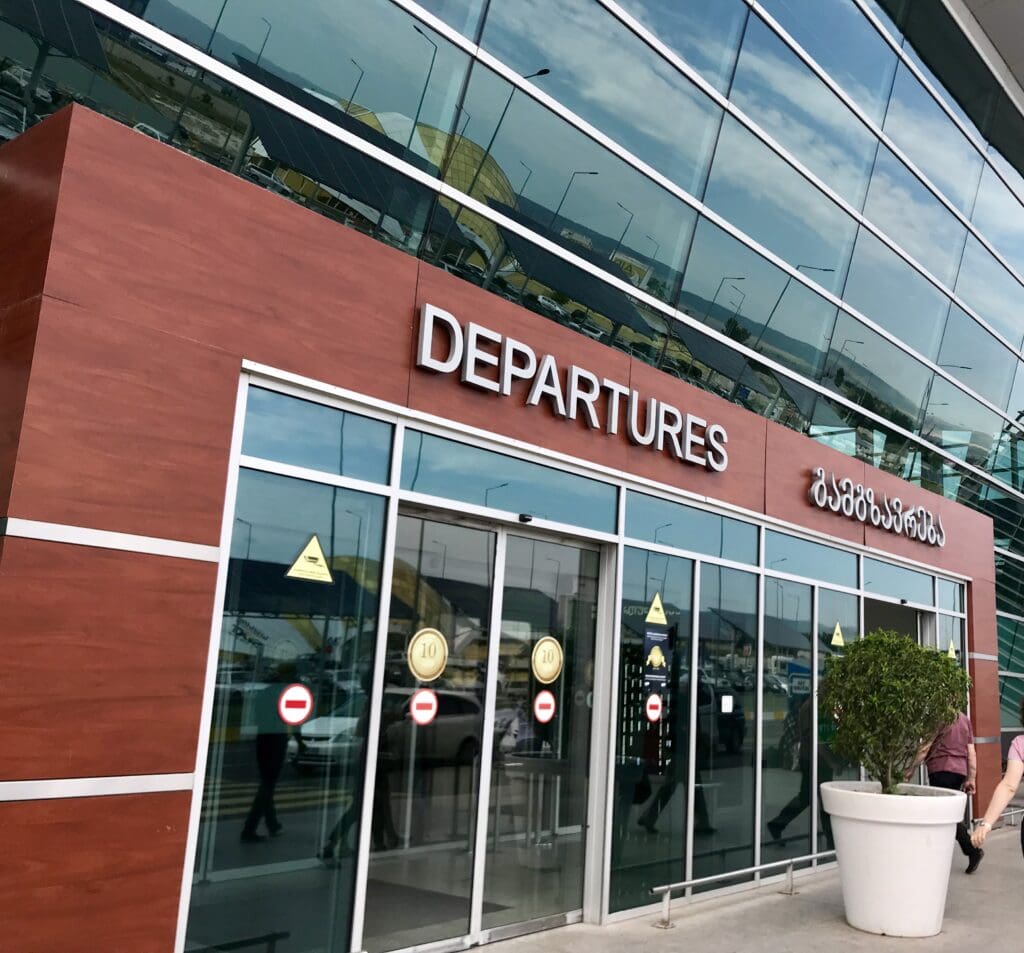
Once at the airport, the bus pulled up outside the check-in hall, and we entered, joining the queue for the quick security check. Despite our morning adventure, we arrived at the terminal at 09:15, still with plenty of time before the scheduled departure and thus in no rush. The relatively small check-in hall was busy, with many flights departing that morning. With low ceilings, a large number of passengers, and a lack of natural light, Tbilisi Airport’s landside area resembled many of Europe’s low-cost terminals. Having arrived too early to check in for our flight and with few places to sit, we took a short stroll around the terminal before stopping at one of the currency exchange booths to convert most of our remaining Lari into Manat.
Once this was done, it was time to head to Buta Airways’ check-in counters at the end of the hall, which had just opened. At this point, long queues were visible at the counters for Air Astana, S7 Airlines, and Turkish Airlines, each with a flight to Almaty, Novosibirsk, and Istanbul, respectively. Interestingly, most passengers for these flights appeared to be tourists. Many of those flying with Air Astana and S7 Airlines were likely Korean, returning home from holidays in the Caucasus, while most passengers for the flight to Istanbul appeared to be from North America, presumably connecting onwards to various destinations across the continent. More intriguingly, I was surprised to see the logo of White Airways both on the flight information displays (FIDS) and above several check-in desks, as the airline was supposedly operating a service to Amman. However, this service turned out to be operated by a Fly Jordan Boeing 737 Classic.
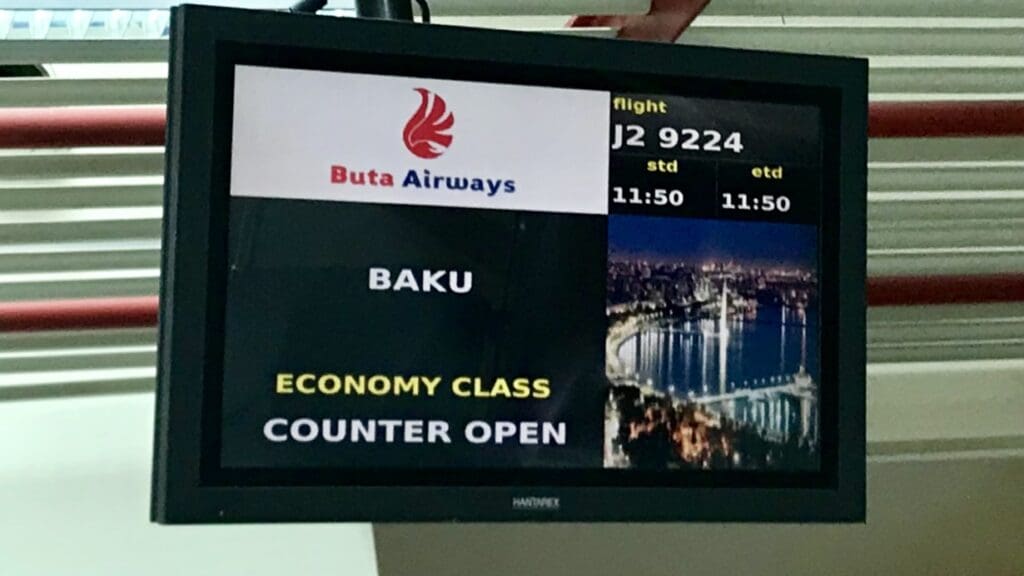
After soaking up the terminal’s atmosphere, we arrived at the Buta Airways counters, where a small queue had formed. Expecting it to move quickly, we were delayed by the fact that only one of the two desks was open, combined with the passengers’ enormous amounts of luggage. It took nearly half an hour to reach the front of the queue. Fortunately, once there, the slightly unfriendly staff member swiftly printed our Buta Airways-branded boarding passes and sent our suitcase on its way to the depths of Tbilisi Airport. With no reason to linger landside, we proceeded to security and immigration, where the queue for our flight to Baku was now at least twice as long as it had been earlier.
Unsurprisingly, given the morning rush, a long, snaking queue led to the security check. However, unlike the check-in queue, this moved at an acceptable pace, and within fifteen minutes, we had passed through and were ready to leave Georgia. Since most immigration booths were manned, there was no queue, and I was able to walk straight up to a desk. Within a minute, I received my exit stamp and was free to enter the airside area.
Whilst I found the airport’s landside area somewhat chaotic, cramped, and cluttered, airside, it was a completely different story. The terminal was modern, spacious, clean, and tidy. Despite the number of passengers, there was ample seating, making it easy to find somewhere comfortable to sit and wait for the flight. For those in need of refreshments, a couple of cafes, a Dunkin’ Donuts, and intriguingly, a British-style pub, were available, in addition to numerous vending machines. Unsurprisingly, a duty-free shop was present for those looking for last-minute souvenirs, including overpriced Georgian wine. As is now expected, free and fast Wi-Fi was available throughout the terminal, and I found it worked smoothly for the duration of my time there. For those wishing to pass the time watching the action outside, floor-to-ceiling windows offered superb views of the apron and runway.
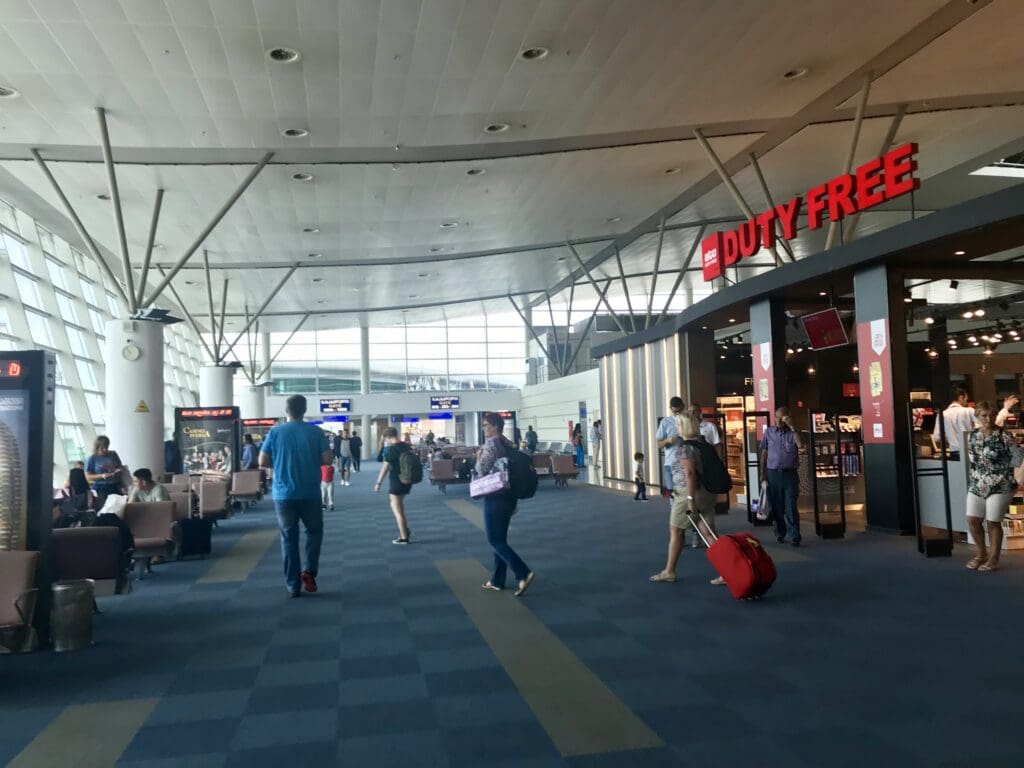
Tbilisi Airport is relatively quiet for a capital city airport, having welcomed just over 3.1 million passengers in 2017. However, that morning, there was no shortage of interesting movements outside. Upon entering the airside departure area, two noteworthy aircraft caught my attention: a pair of active Ilyushin 76s—one operated by Belarusian cargo carrier Ruby Star Cargo and the other by the lesser-known Ukrainian airline Yuzhmashavia. A little later, a smoky four-engine vintage Antonov 12BK came into view, making a rather steep approach to the airport. Its livery, mostly white with orange and blue stripes, was typical of several former Soviet nations’ Ministries of Emergency Situations, leading me to initially assume it was a government aircraft. However, it turned out to be operated by Kazakh cargo airline Jupiter Jet Airlines. The distinct livery was a legacy of its previous life with the Kazakh Ministry of Emergency Situations’ Kazaviaspas. Beyond these rare cargo planes, there were a few familiar carriers at the terminal—an Air Astana Airbus A321, an S7 Airlines Airbus A320Neo, and a Turkish Airlines Boeing 737-900ER—alongside the aforementioned Fly Jordan Boeing 737-300 and an AMC Airlines Boeing 737-800 preparing for a long flight to Hurghada.
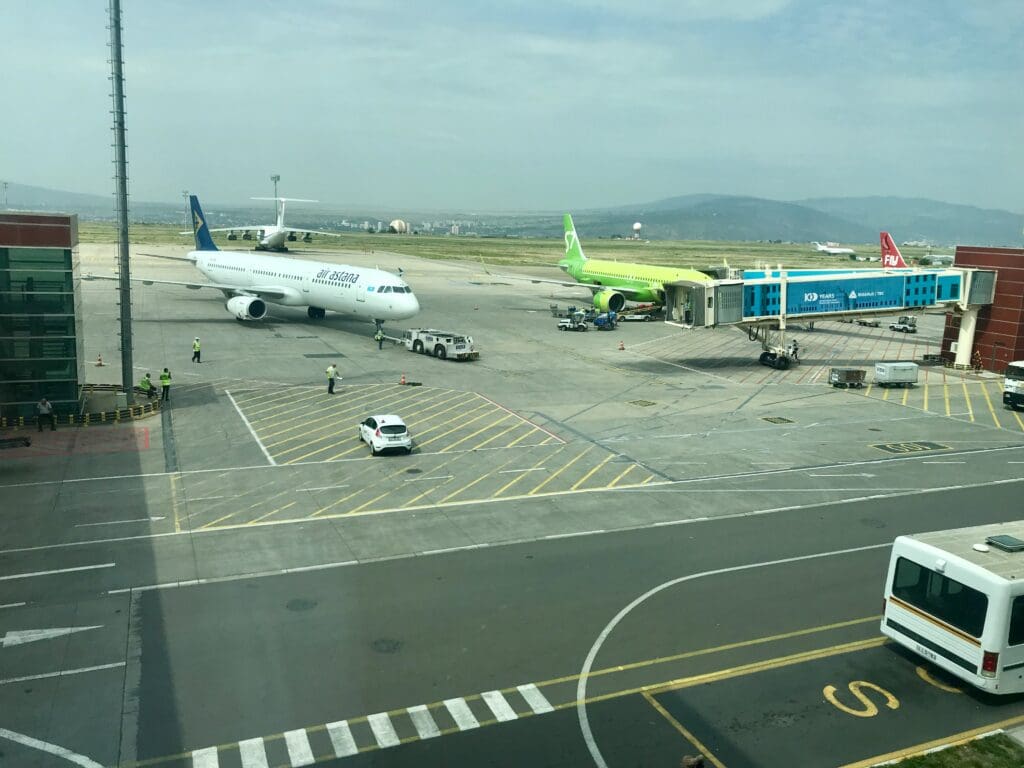
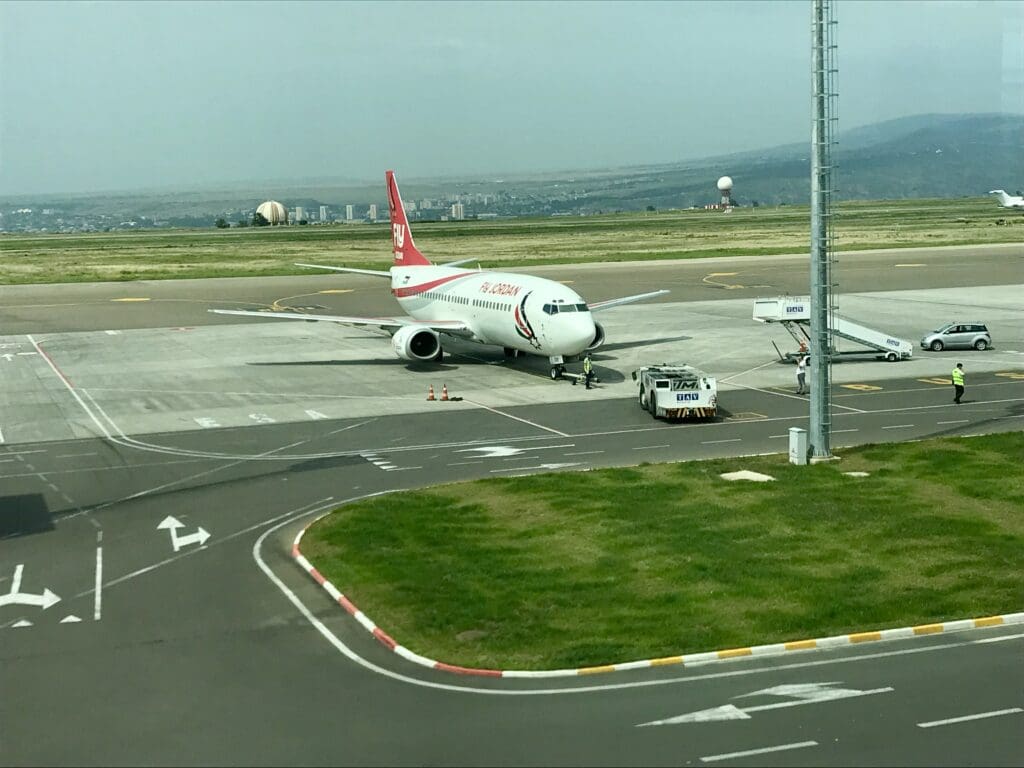
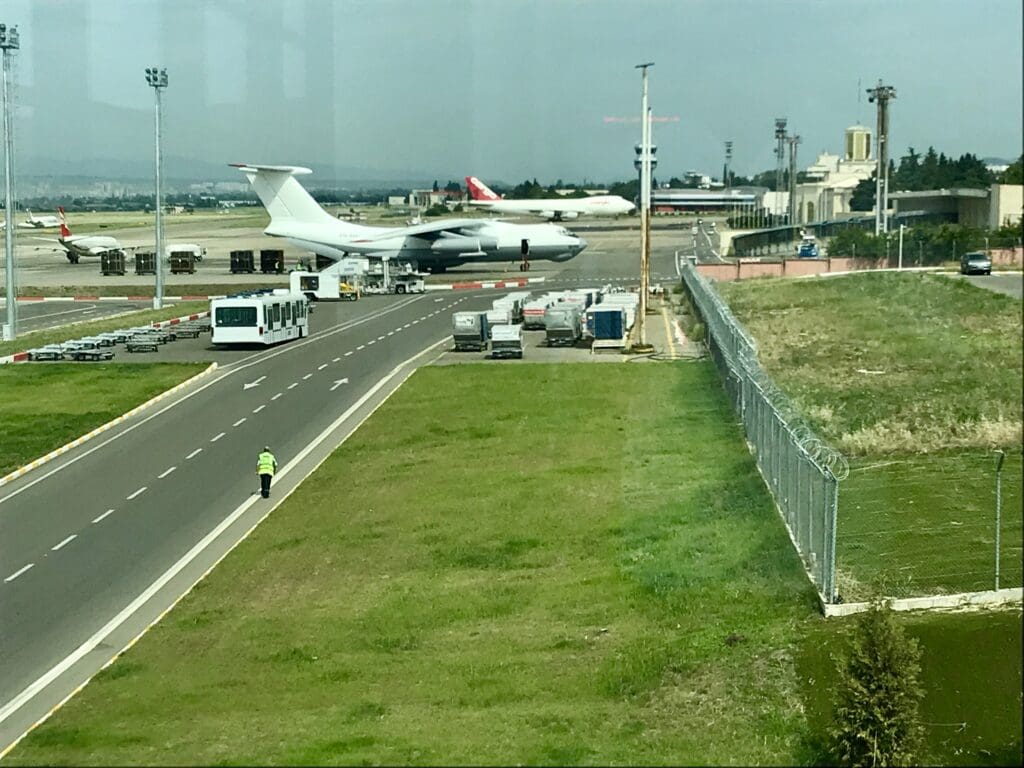
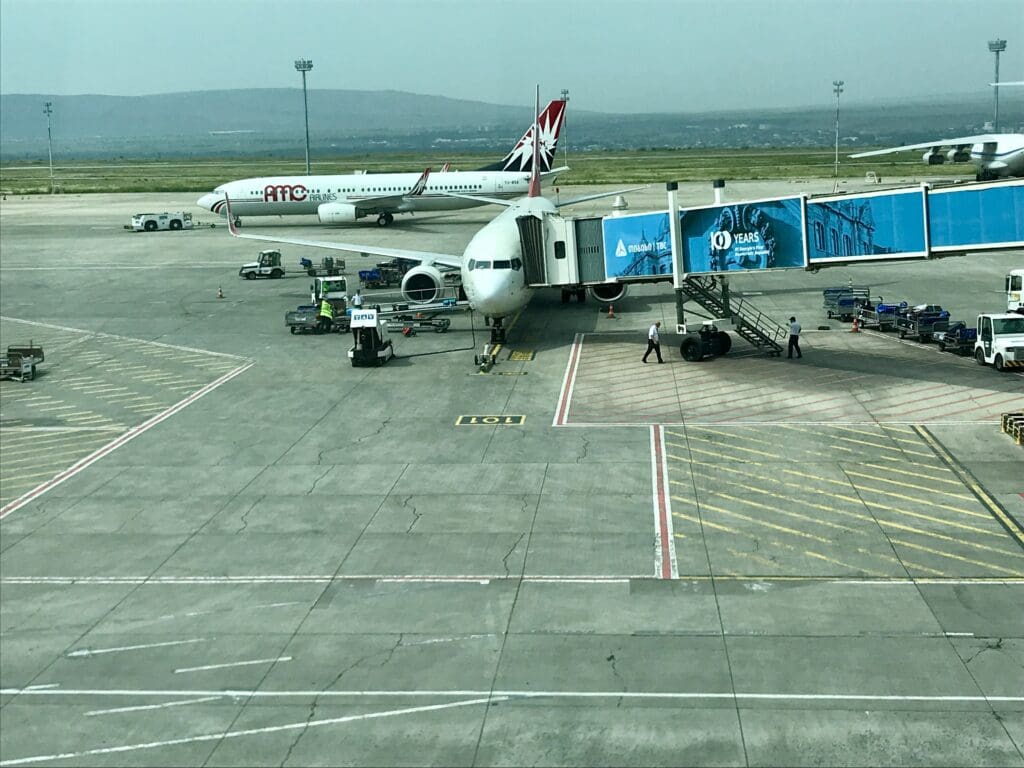
After observing the aircraft movements, I turned to Flightradar24 to track our inbound aircraft from Baku, but the aircraft’s position was patchy, and it wasn’t visible for much of its short flight. By chance, I happened to be looking out the window when the short, stubby Embraer 170 touched down, slightly ahead of schedule, before taxiing to remote stand 113. Not long after, at 11:00, the FIDS updated, informing Baku-bound passengers to proceed to bus gate 203. As we made our way there, we saw a trio of buses, with their drivers seemingly engaged in a serious discussion with a crowd of security guards. Once the announcement was made inviting passengers to board, the gate filled up quickly, and it became clear it would be a full flight to Azerbaijan that afternoon. The majority of passengers appeared to be from Azerbaijan and Georgia, though I noticed a few from China, France, India, Saudi Arabia, and the US.
As the flight’s boarding time drew near, aside from the security guards and bus drivers, there were no staff members at the gate. When the scheduled boarding time arrived, nothing seemed to happen. The ‘go to gate’ messages on the FIDS were replaced with ‘wait in lounge.’ Interestingly, we were not the only ones facing delays—outside, a team of engineers was gathered around an Air Astana Airbus A321’s engine, with announcements every few minutes apologising for the Almaty-bound flight’s delay. In contrast, passengers flying with Buta Airways were kept in the dark about their delay. While several passengers questioned the security guards, it was clear they knew no more about the situation than the passengers themselves.
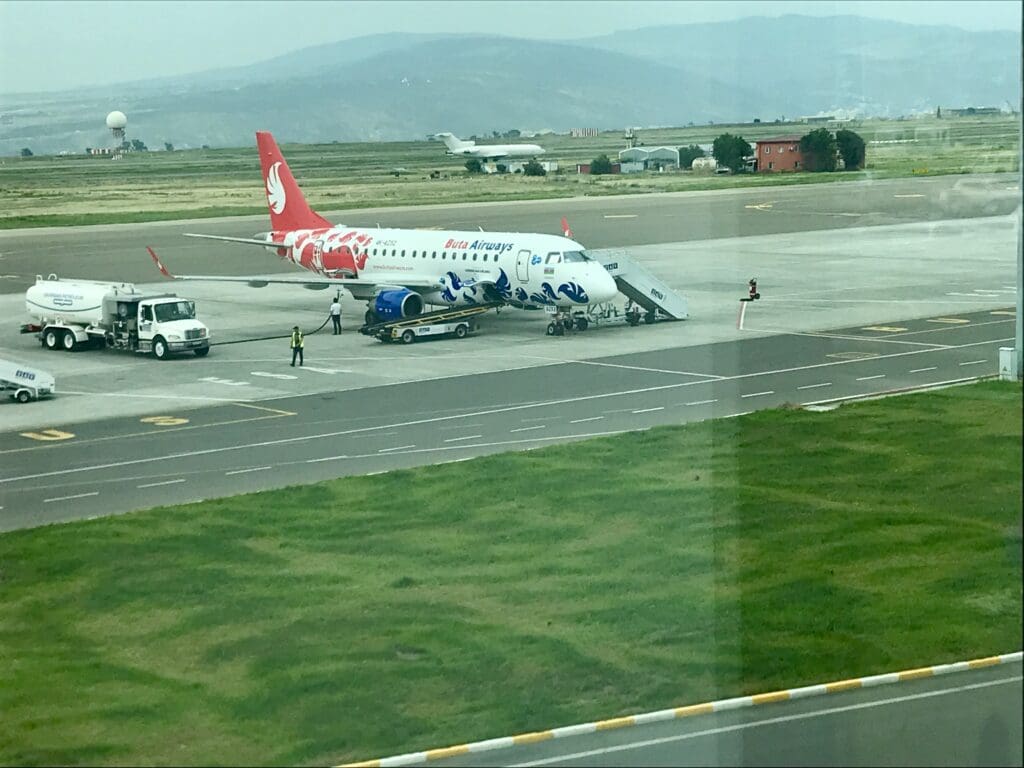
Almost 40 minutes after the flight’s scheduled departure time, the station manager, looking a little flustered, was seen speaking on his phone outside. Shortly after, three airport workers came down the escalators and headed to the desk. Without any formal announcement, boarding suddenly commenced. Passengers had their boarding passes scanned one by one before heading outside to the buses. Once my boarding pass was scanned, I boarded the bus, which quickly filled up. After all passengers were packed in like sardines, one of the airport workers gave a nod of approval to the driver, and the doors closed. The bus slowly made its way over to the aircraft, and less than a minute after leaving the terminal, we came to a stop, spilling out onto the apron.
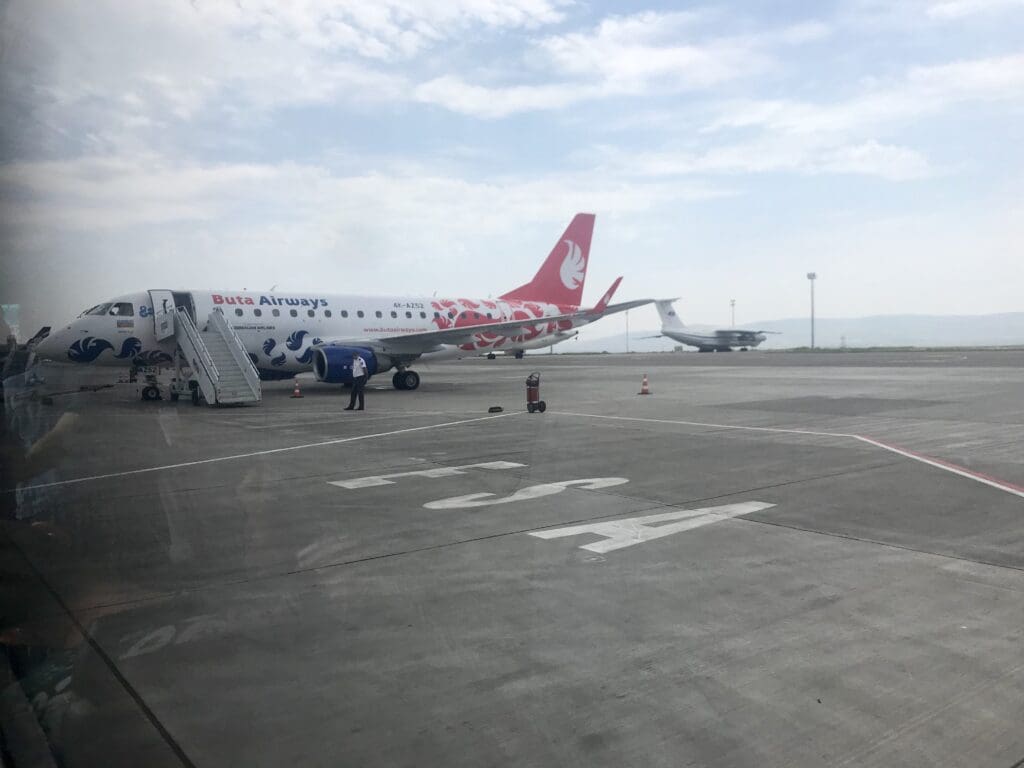
At the time of our flight, Buta Airways operated a single Embraer 170 in its fleet, but this aircraft was retired and placed in storage just two months later, in August 2018. Assuming no last-minute equipment changes, it was fairly easy to predict which aircraft would be making the flight to Baku that afternoon. Sure enough, waiting at the stand was 4K-AZ52, an Embraer 170LR named Zagatala after a small city in northwestern Azerbaijan. This particular aircraft had a special history, as it was the second-ever E-Jet to be manufactured, making it the oldest example in commercial service at the time of my flight. Piloted by Embraer test pilots Rodrigues and Kovacs, along with engineer Algodoal, this aircraft first took off on 9 April 2002, for a three-and-a-half-hour test flight over Brazil, with the registration PP-XJC. Just two months after its first flight, it was initially intended for Swiss regional carrier Crossair, but after the airline’s takeover by Swiss, the aircraft remained in Brazil as an Embraer test aircraft.
In April 2006, it was painted into the new colours of Indian airline Paramount Airways, with the registration VT-PAC. After four years in India, the airline’s closure saw the jet returned to its lessor, EGC Leasing, and it was given a Manx registration. After being stored in Europe for three years, the aircraft appeared at Southend in August 2013, painted into Azerbaijan Airlines’ livery by Air Livery, with the registration 4K-AZ52. Finally, when Buta Airways, Azerbaijan Airlines’ low-cost subsidiary, was formed in October 2017, the aircraft entered the paint shop once more, this time in Tallinn, Estonia, where it received its final livery.
Returning to the journey, given that most passengers seemed to be carrying more hand luggage than usual, and with no one handing over bags to be checked in at the last minute, boarding was a slow process. However, considering the pleasant weather that day and the opportunity to admire this legendary Embraer aircraft, I didn’t mind. After making my way up the airstairs and entering the small forward galley, I wasn’t greeted by the two flight attendants stationed there. As I made my way down the cabin, I eventually arrived at seat 30L, only to find a couple of friends sitting together. One of them asked if I could move to his original seat, 23H. Since my father didn’t particularly mind not having a window seat, he took this seat while I headed to 31A, my father’s original seat. Despite my initial cold interaction with the crew, I was warmly greeted by a middle-aged man with an impressive moustache standing at the rear of the cabin. Initially unsure whether he was a friendly engineer or a member of the cabin crew, I soon discovered he was the latter. After returning the greeting, I took my seat and settled in for the short flight ahead.
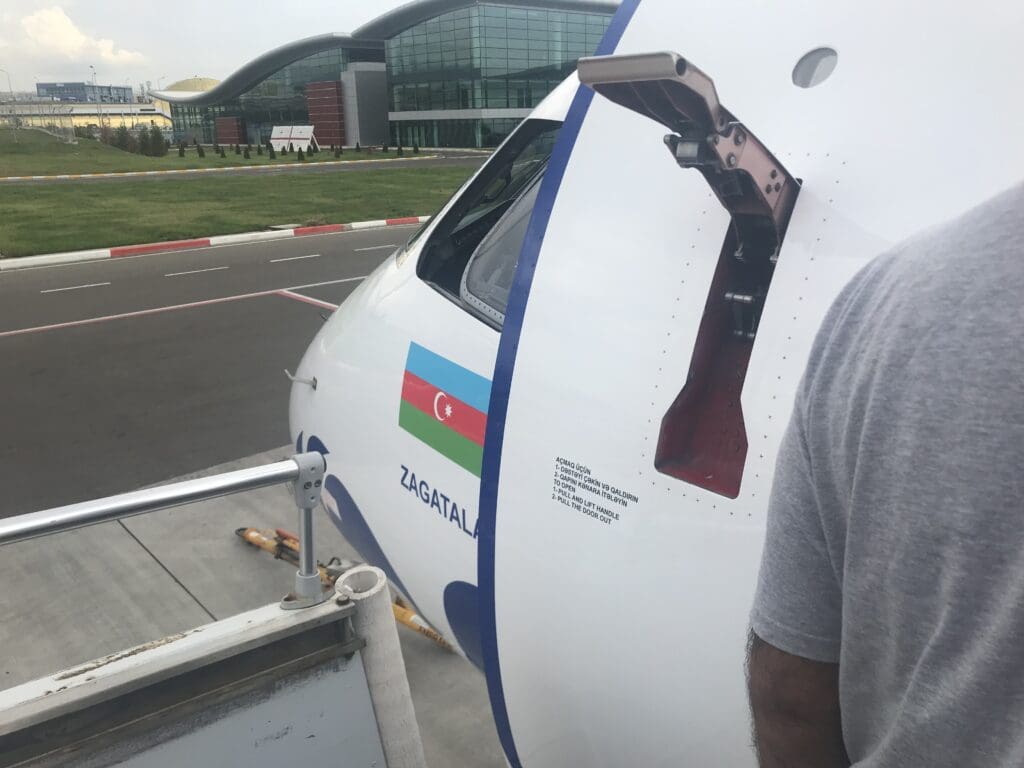
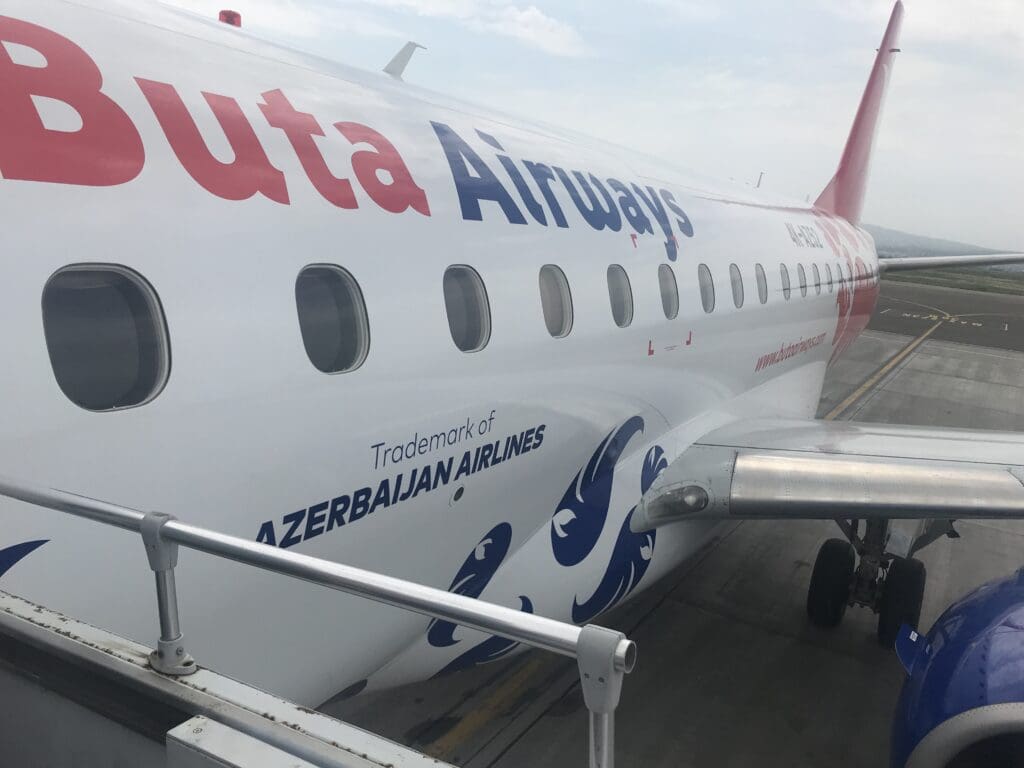
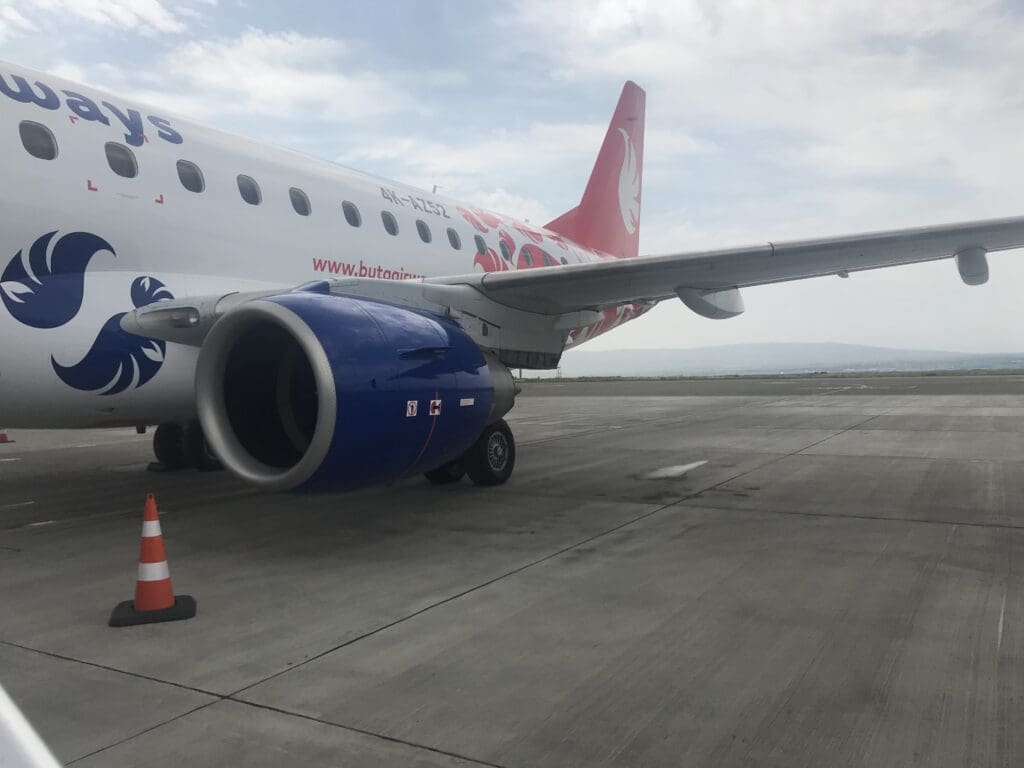
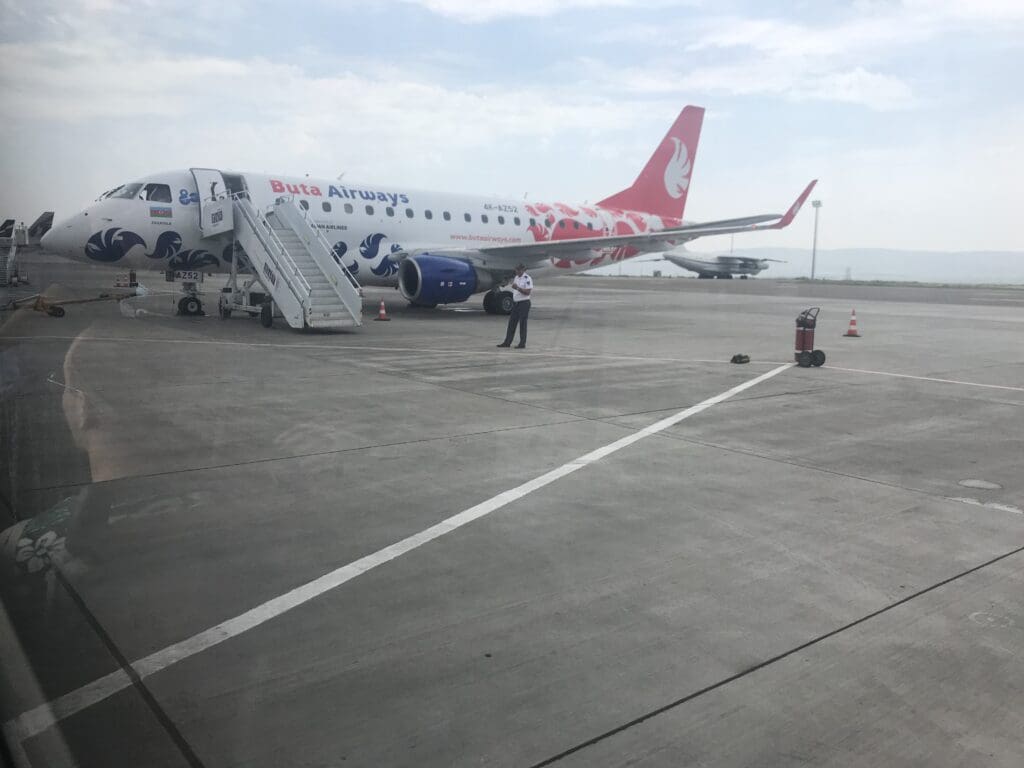
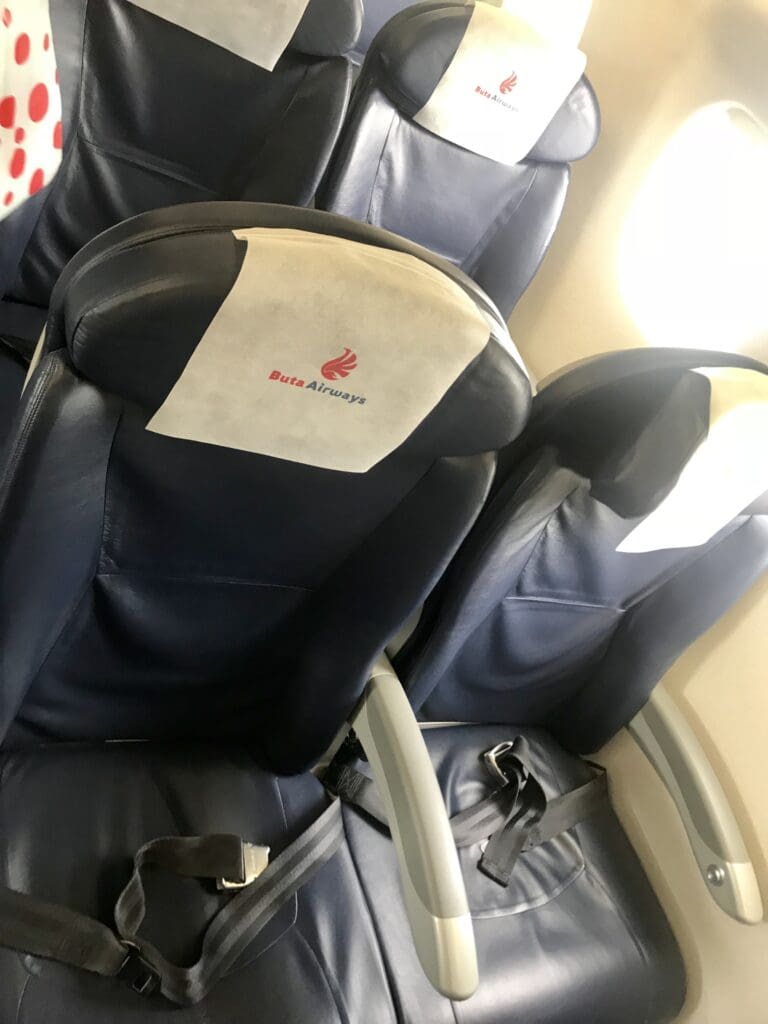
Onboard, the aircraft’s 76 seats were typical of an E-Jet—covered in blue faux leather. Each seat featured a disposable antimacassar, with the more expensive pre-selectable seats offering extra legroom. Those at the front of the cabin had red headrest covers, while all other seats had white headrests adorned with the airline’s logo. Despite the aircraft’s ‘old’ age and rich history, few signs of wear and tear were visible in the cabin. However, it was disappointing to find crumbs scattered around, suggesting only minimal cleaning had been done during the longer-than-usual turnaround time. The seatback pockets contained the usual items, including a sickbag, a safety card, and the spring 2018 edition of Buta Airways’ self-titled inflight magazine.
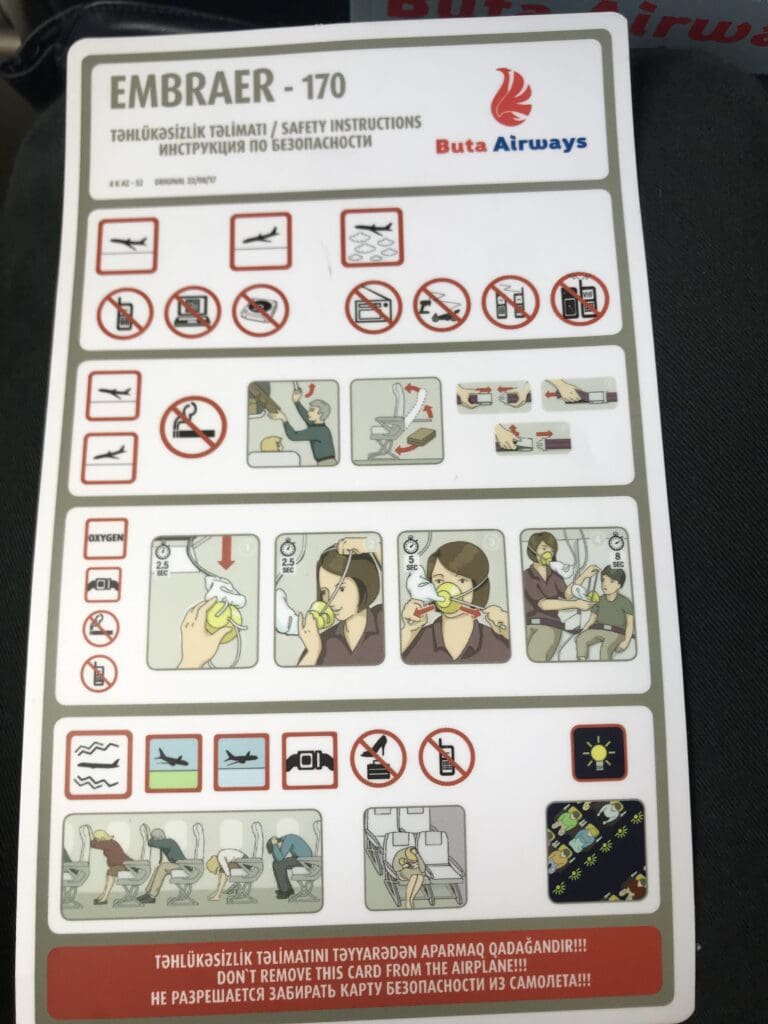
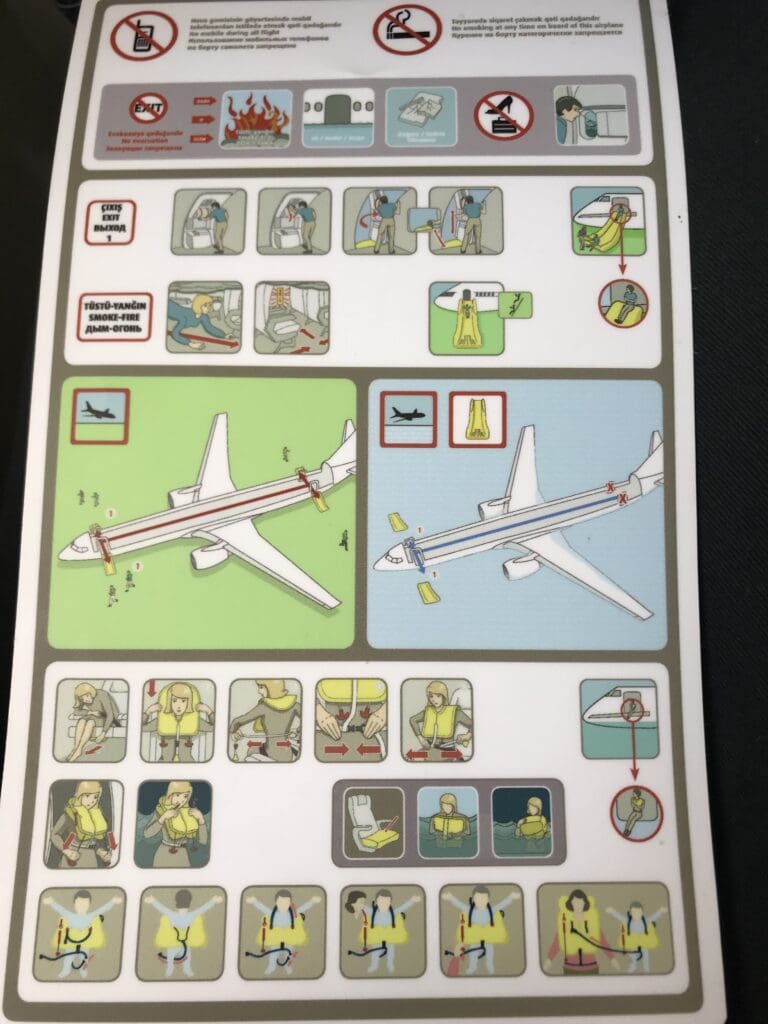

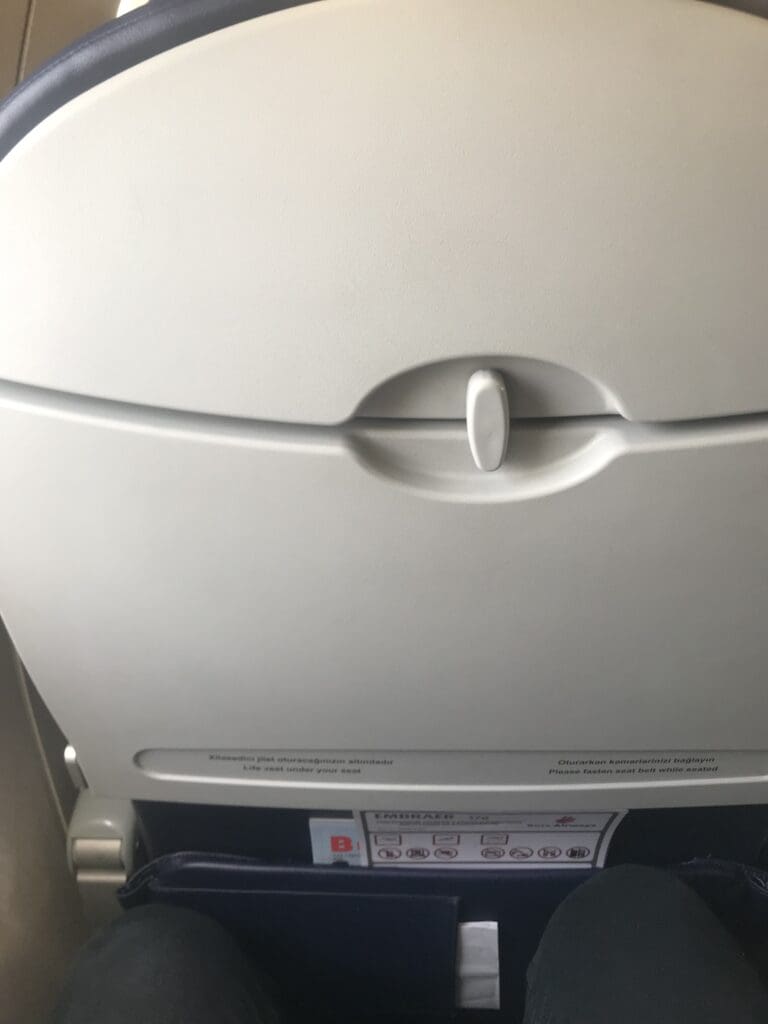
Looking outside, by the time I had reached my seat, the bus that had taken us to the aircraft had already headed back to the terminal. With very few empty seats left, it seemed like all passengers were on board. Despite this, there was no sign of movement—the airstairs remained connected to the aircraft, and the L1 door was still open, with two flight attendants standing in the forward galley, silently awaiting passengers. As the flight’s delay grew longer, no announcement was made. Thirty minutes after boarding, one of the crew members passed through the cabin, distributing water in plastic cups.
An hour and twenty minutes after the scheduled departure time, at 1310, a bus was seen approaching the aircraft, accompanied by a police car. Upon stopping, a policeman stepped out and waited at the bottom of the stairs as a group of smartly dressed passengers boarded. Given the police escort, their business attire, and the fact that the aircraft had been held for them, it seemed likely these were important passengers. Once the last of them had boarded, every seat on the aircraft was taken, and the final passenger had to sit on one of the jump seats in the rear galley.
Even after these passengers had boarded and settled in, there was still no sign of departure. A few passengers were visibly frustrated. For the next 20 minutes or so, a dispatcher hurried between the cockpit and the cabin before the L1 door was finally closed and the airstairs were removed. At this point, the purser made a brief welcome announcement in Azeri and English, followed by a pre-recorded safety announcement and a manual demonstration by a crew member. Pushback occurred at 1340, and despite the delay, the view from the terminal had become more interesting. Most notably, a Kish Air Airbus A321 bound for Tehran was parked with a hybrid Aeroflot-Kish Air livery, and a Ural Airlines Airbus was preparing to head back to Moscow.
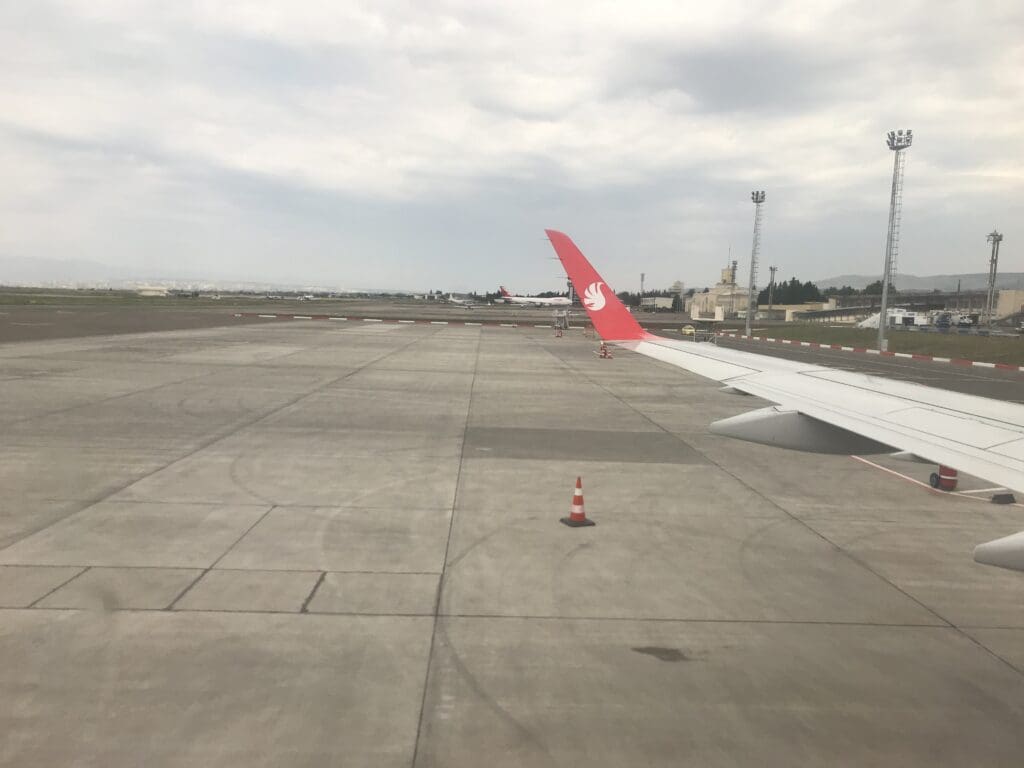
After passing the terminal, the Embraer 170 taxied past a small hangar where an Embraer 190 from my previous flight was receiving light maintenance. Outside the hangar, a 1984 Cessna Citation was on sale for $350,000. The aircraft continued towards the end of Runway 31L, pausing briefly to allow a Nordavia Boeing 737-500, arriving from St. Petersburg, to land. At 1343, the Embraer 170 took off with a rolling departure, climbing over Tbilisi and heading towards Mtskheta, the former capital of the Kingdom of Iberia.
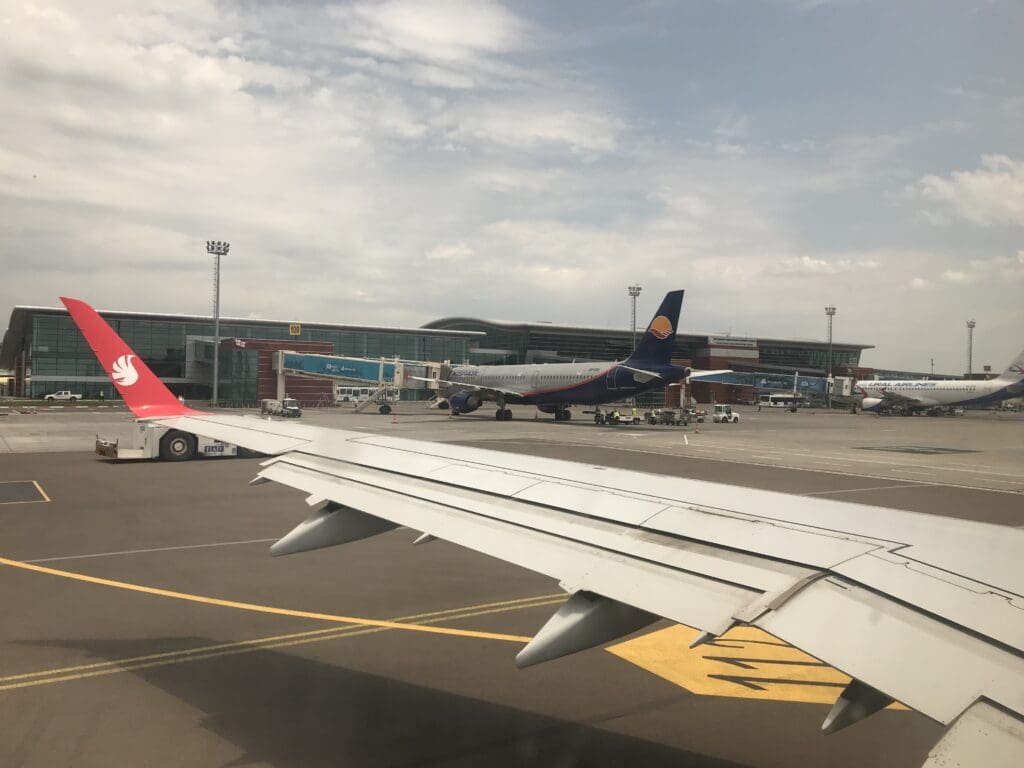
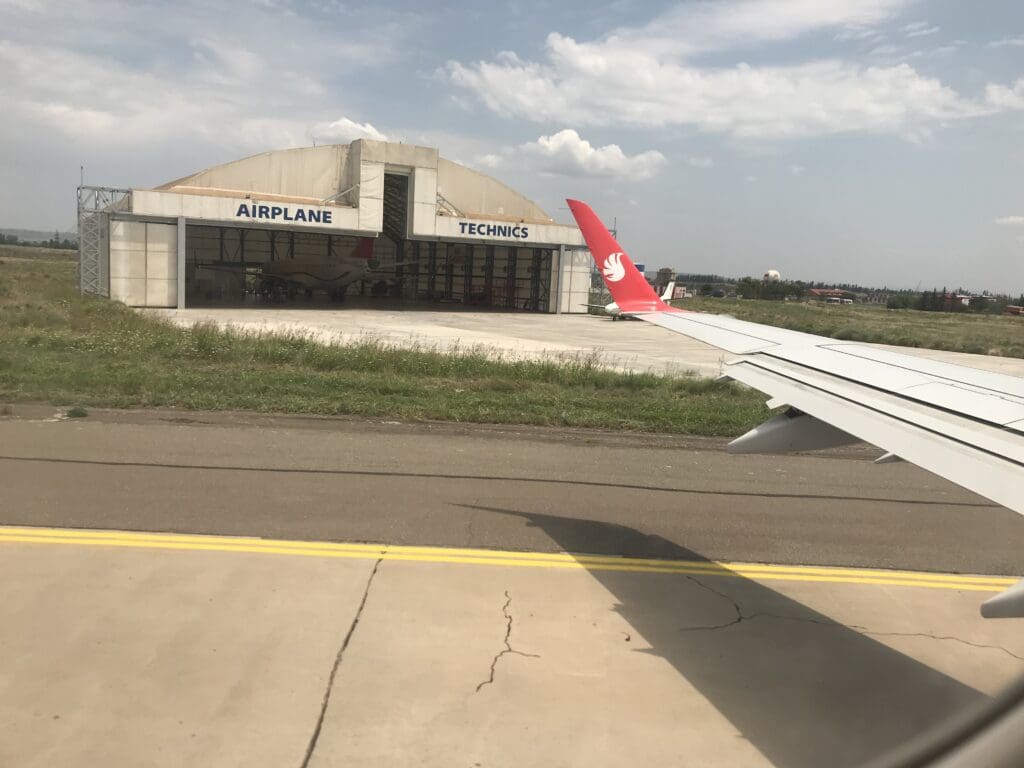
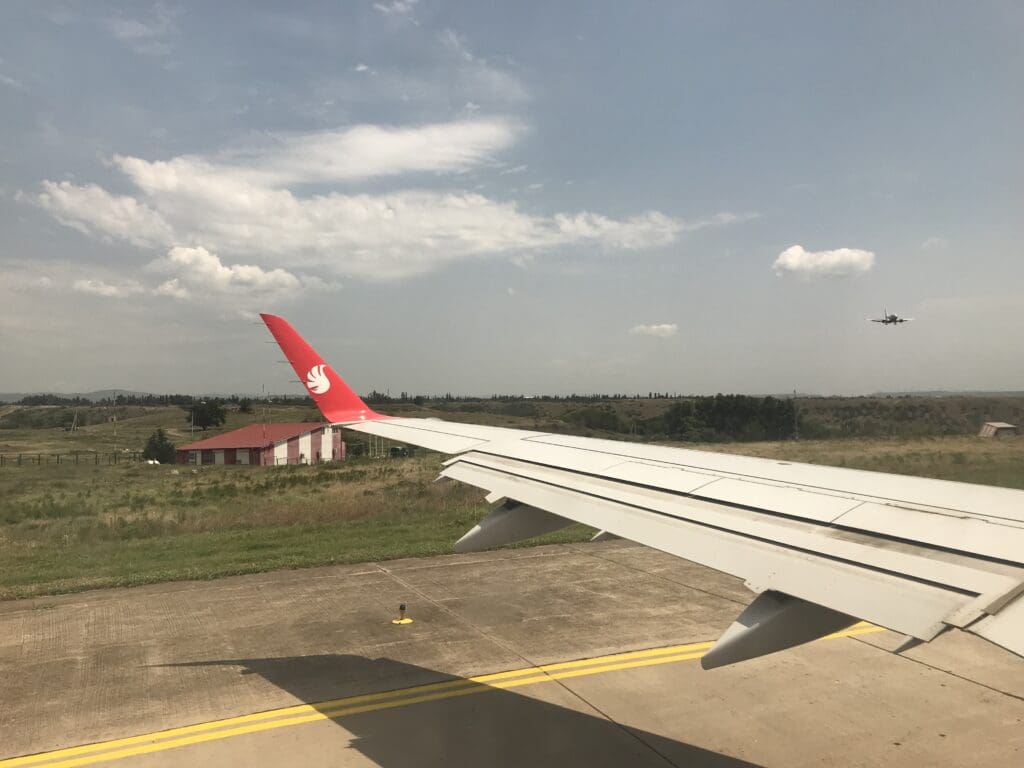
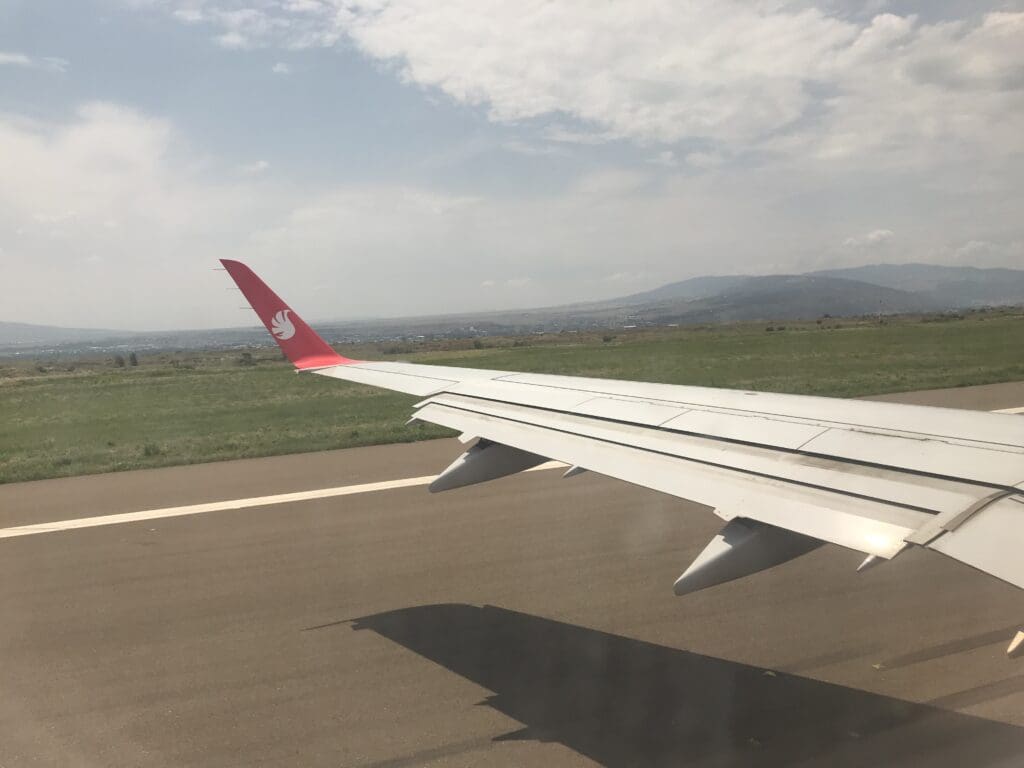
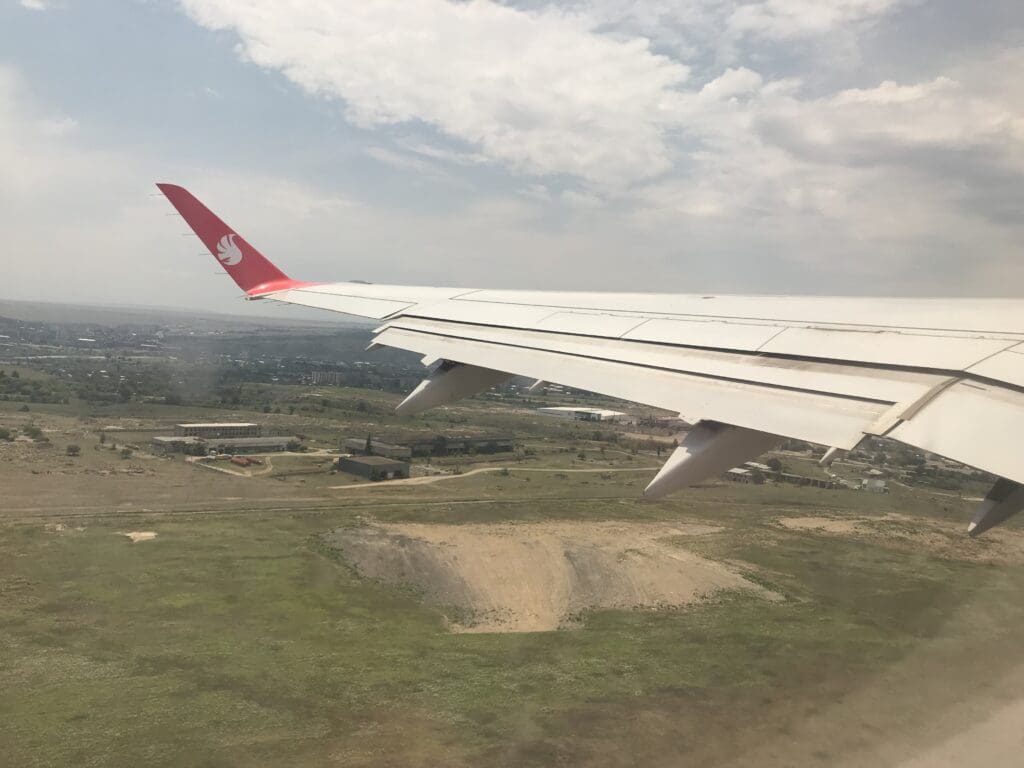
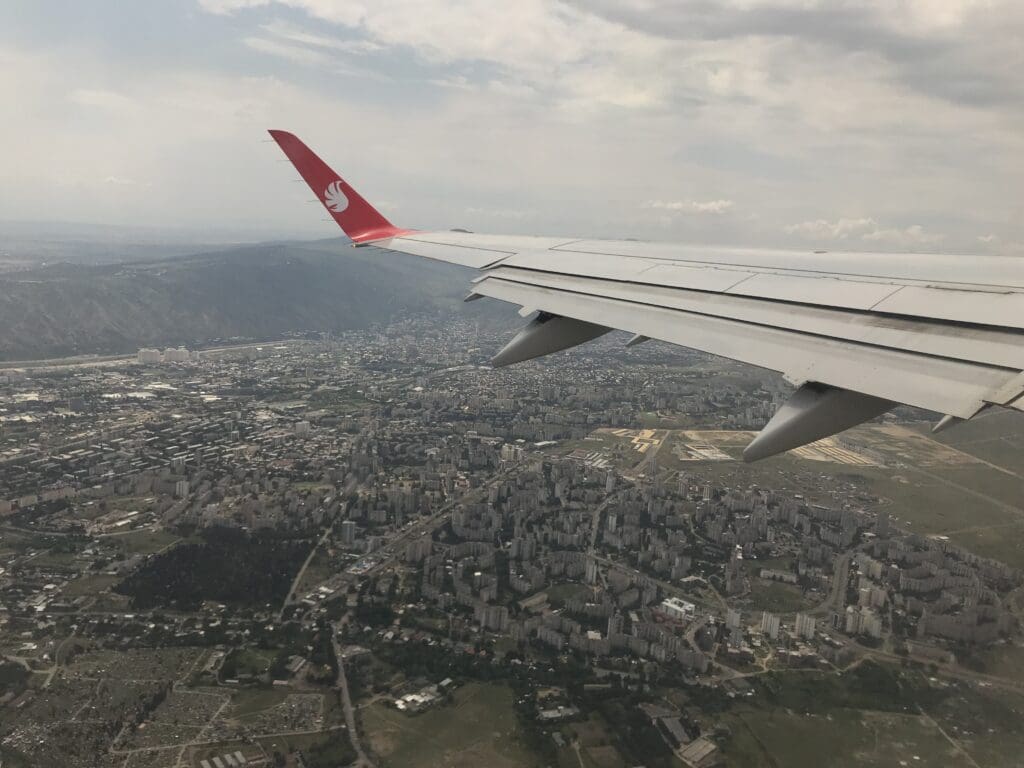
During the climb, I realized that my last-minute seat change was a blessing, as it offered great views of central Tbilisi. As we approached the famous Jvari Monastery, the aircraft made a near-180-degree turn toward the Azerbaijani border. Clouds eventually obscured the view below, but they cleared in time for a final glimpse of Tbilisi Airport before we headed east towards the semi-desert areas outside the capital.
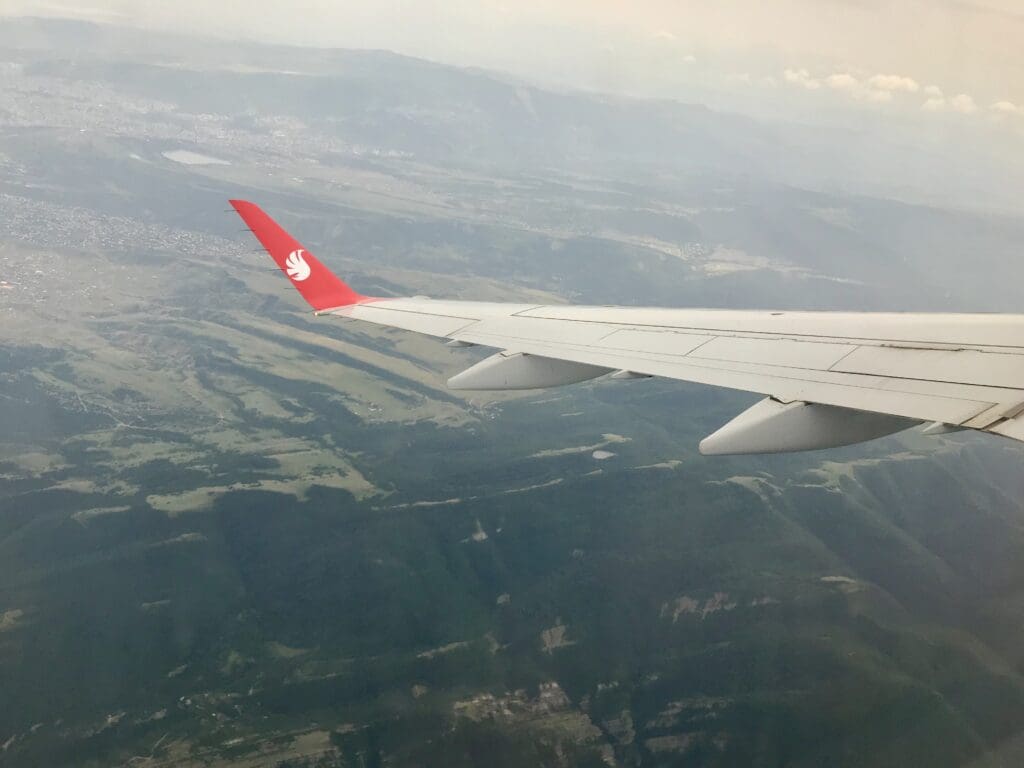
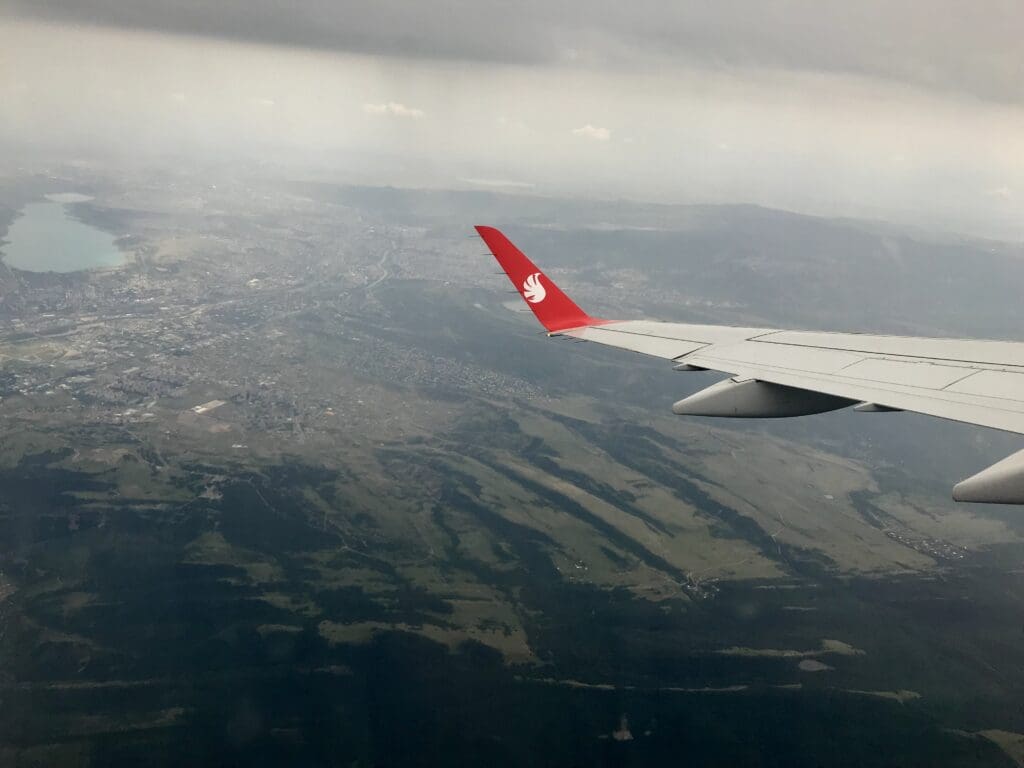
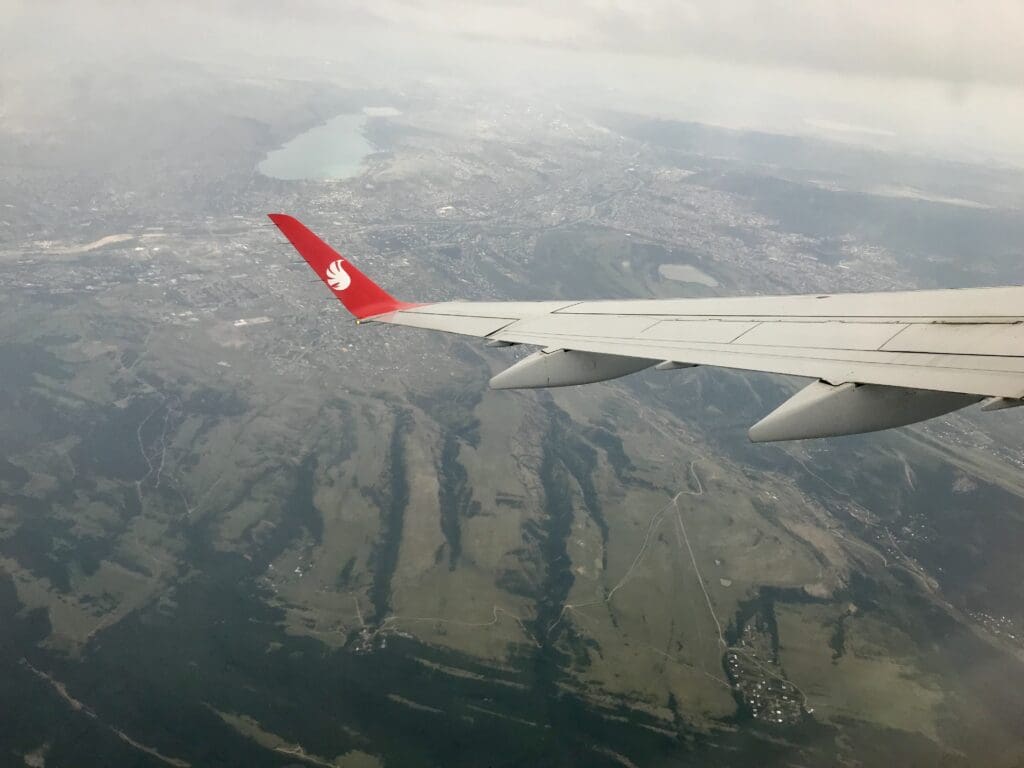
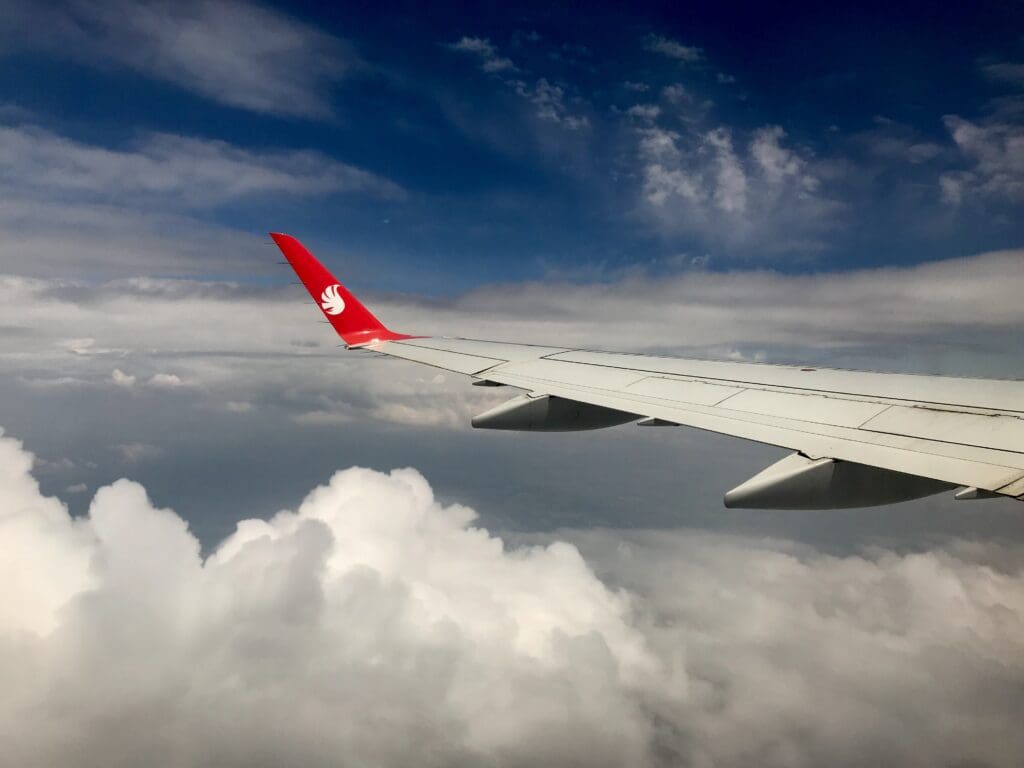
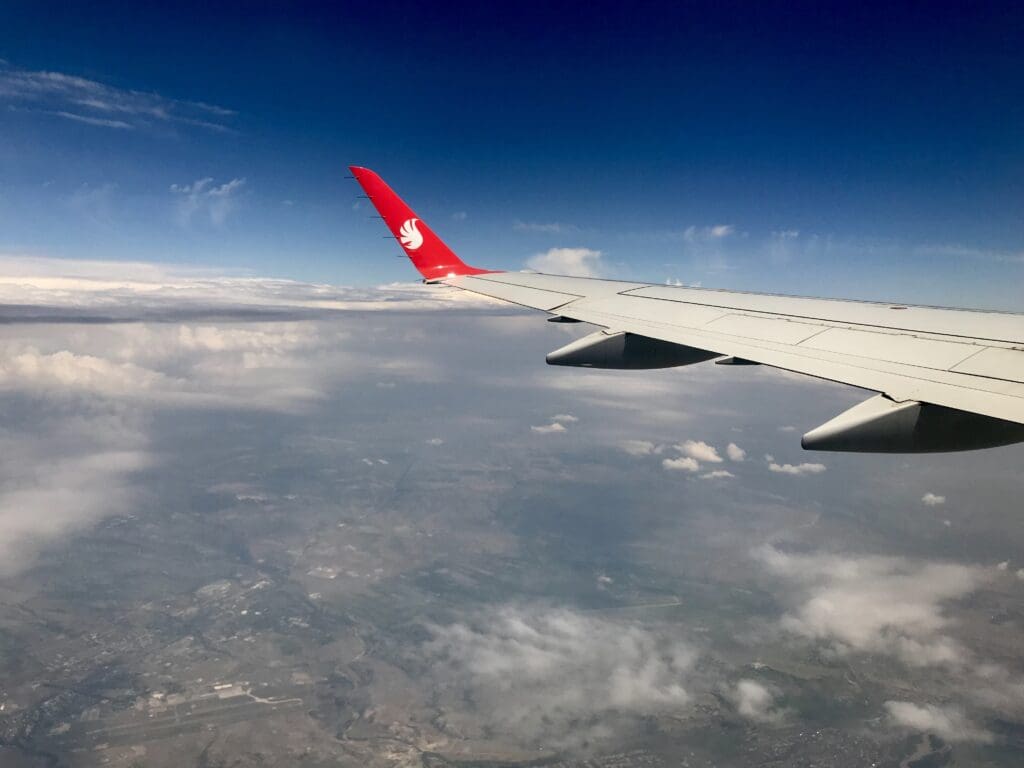
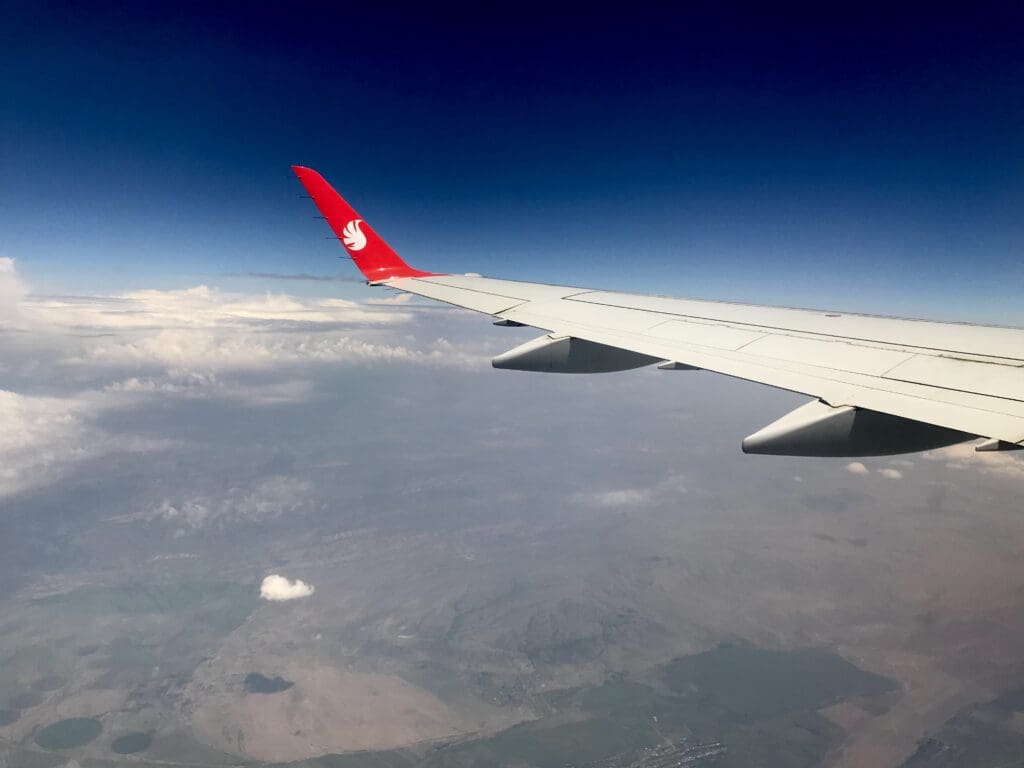
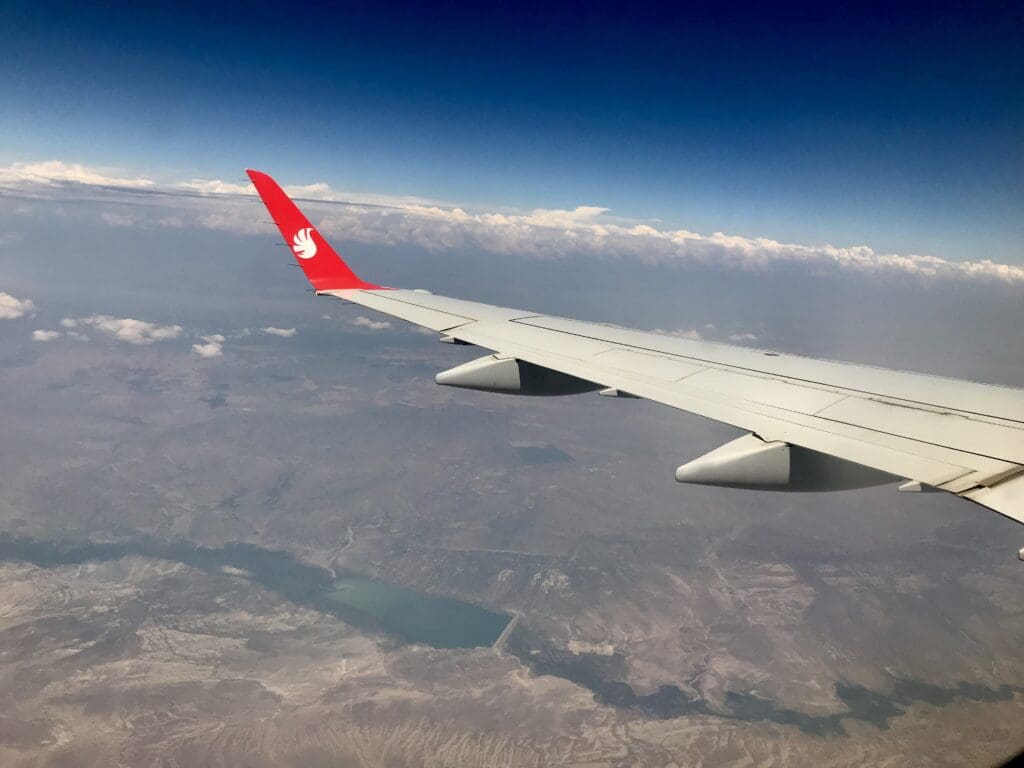
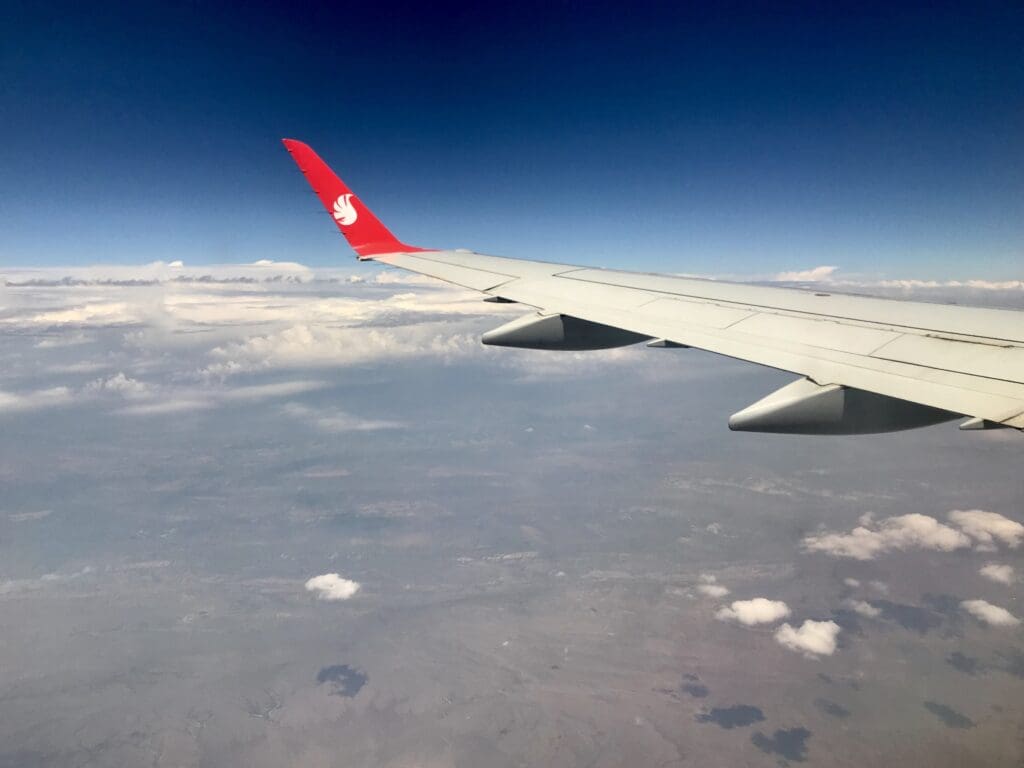
At 27,000 feet, the crew began serving the inflight offerings: water and chicken and cheese sandwich rolls. Despite the crew’s initial cold demeanour, the service was conducted in a friendly and polite manner. However, by the time the crew reached the back of the aircraft, only cheese sandwiches remained. Though the sandwiches were quite good, many passengers were surprised to find that tea and coffee, which were offered next, weren’t part of the complimentary service. These beverages were priced at 0.5 and 0.7 Euros, respectively.
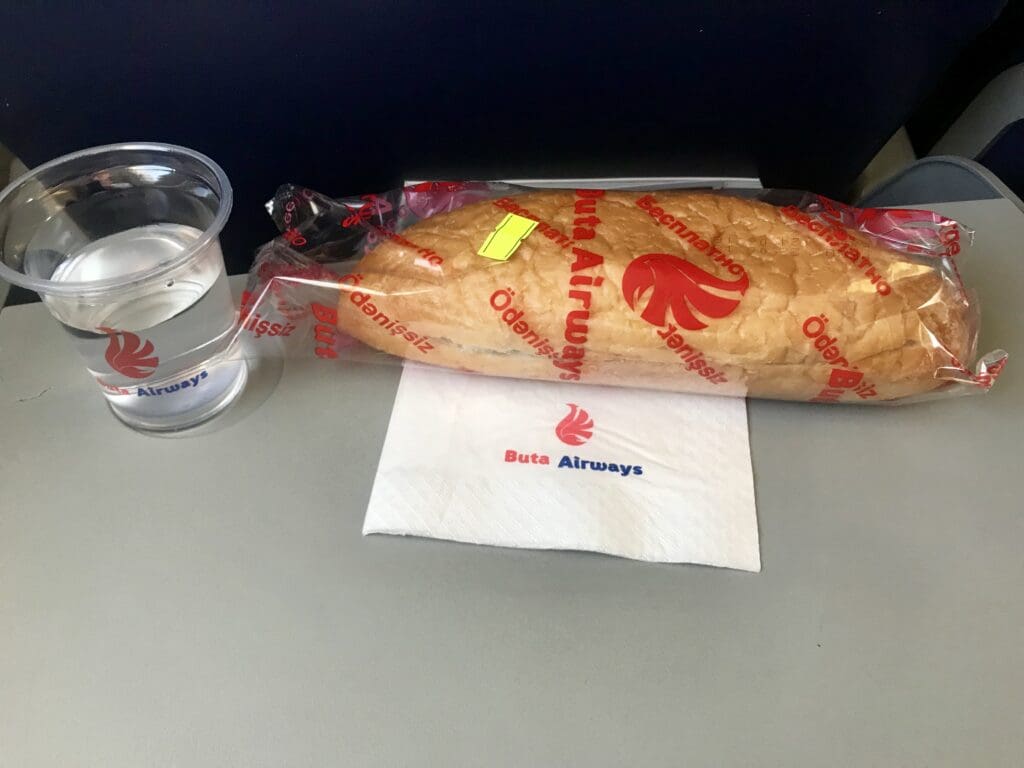
Thirteen minutes after reaching cruising altitude, the Embraer levelled off and flew over the Georgia-Azerbaijan border near Rustaveli. After another ten minutes, we saw Georgia’s largest reservoirs—Semkir and Mingachevir—before flying over sandy fields and tall, snow-capped mountains in Azerbaijan. Though I was spending less than 24 hours in Azerbaijan, the stunning scenery made me eager to explore the country in the future.
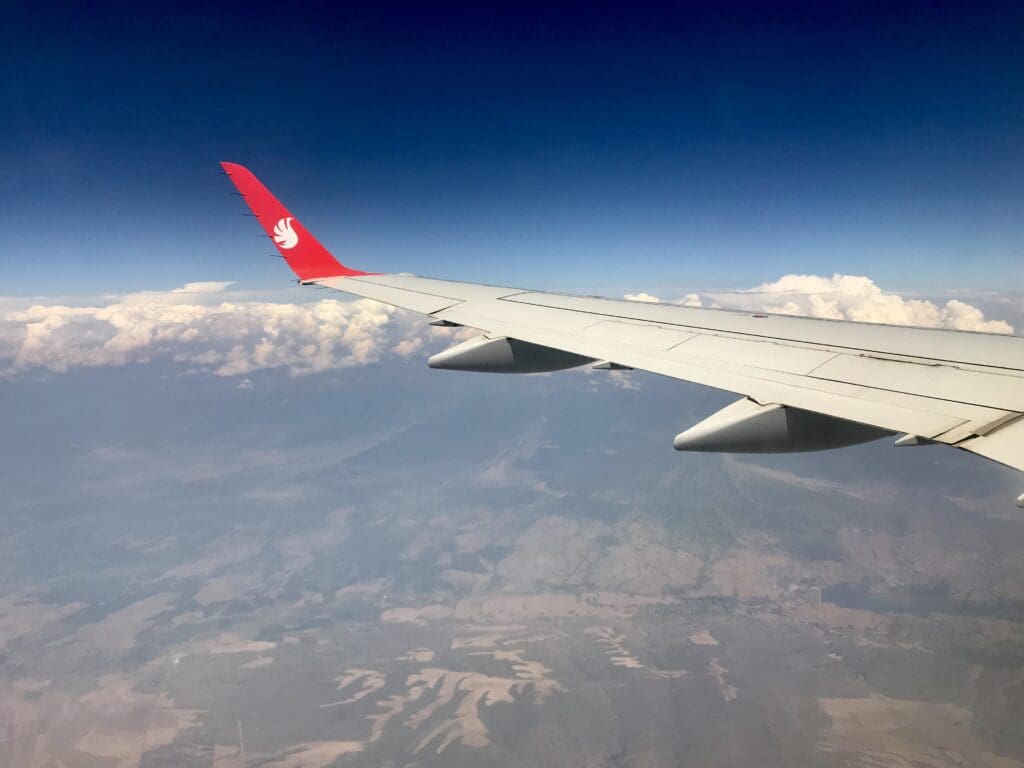
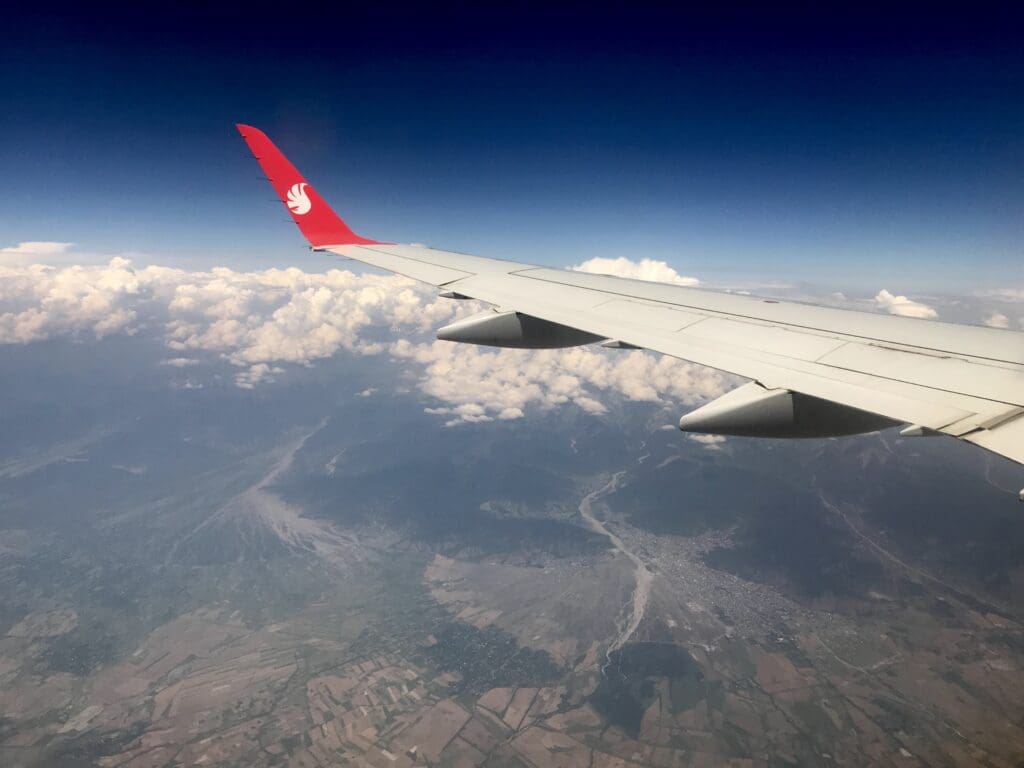
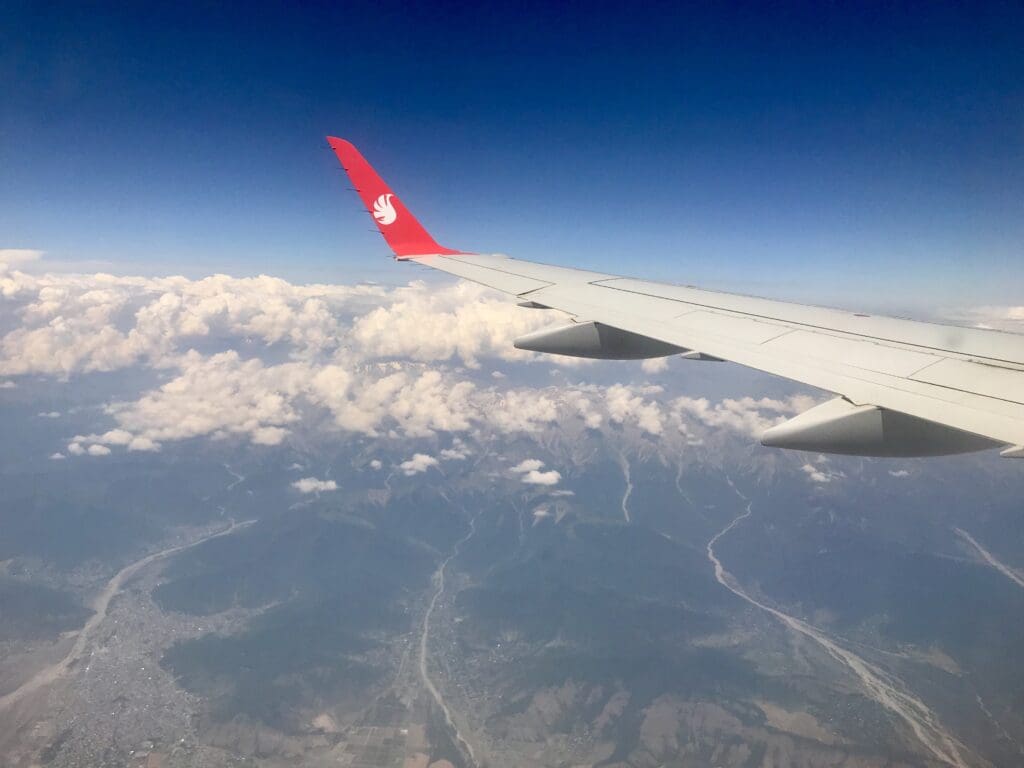
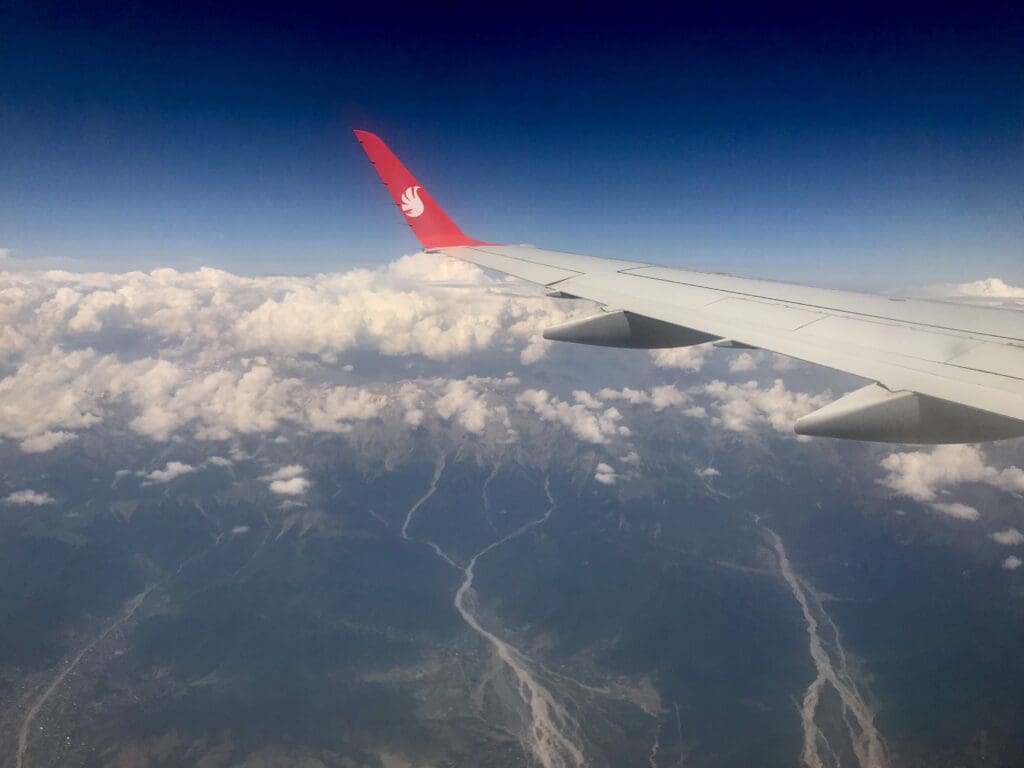
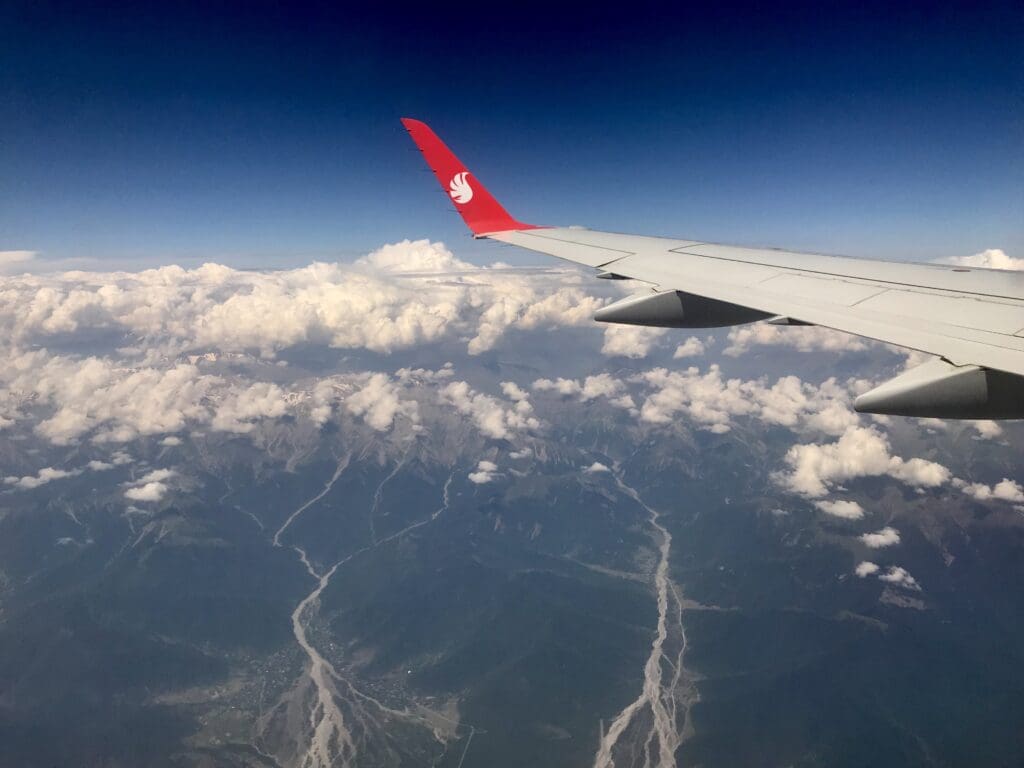
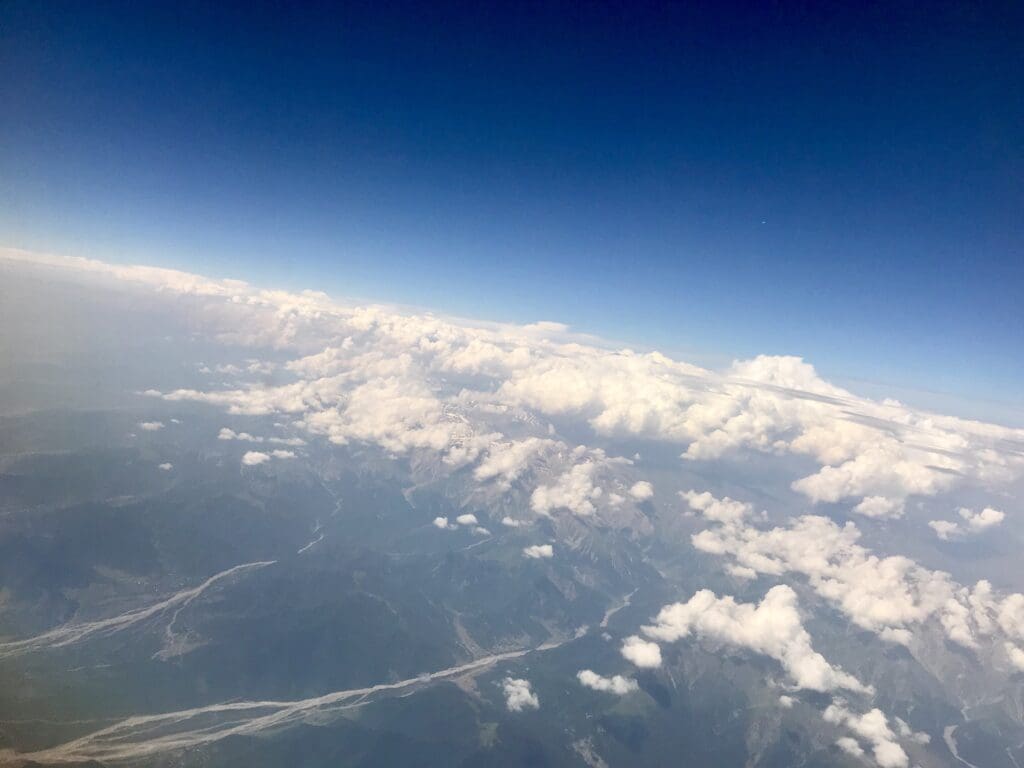
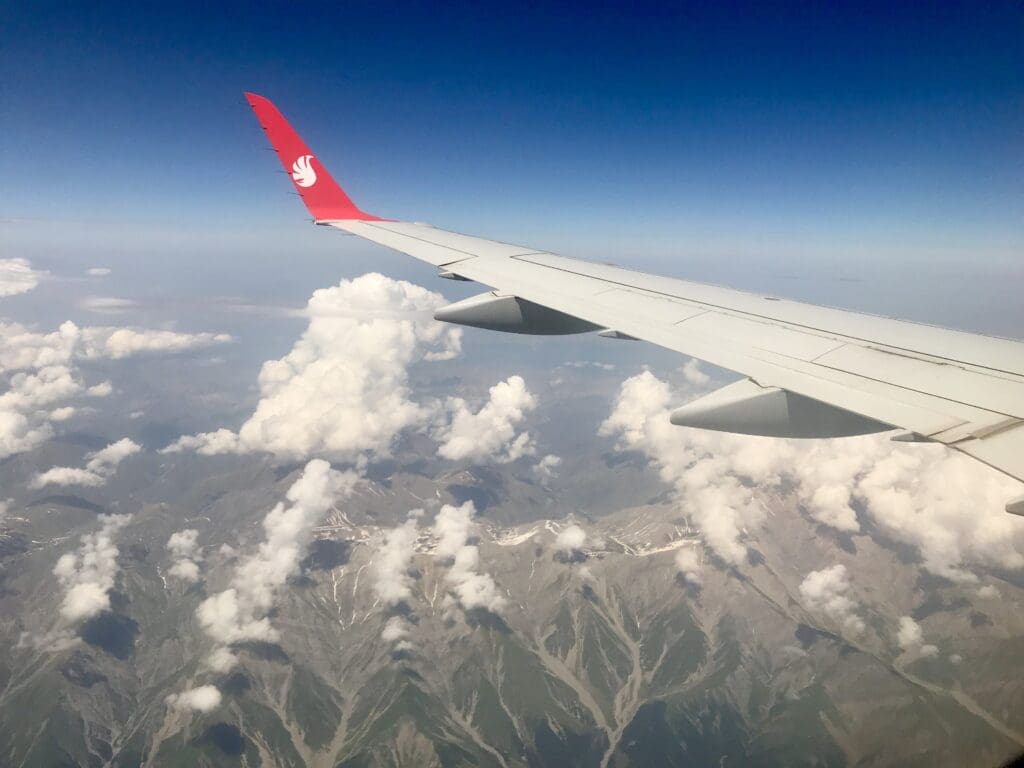
After finishing my sandwich, I visited the bathroom, which was surprisingly clean and well-maintained, likely due to the short flight time. Back at my seat, I flipped through the in-flight magazine, which offered articles in Azeri, English, and Russian, covering topics like Azerbaijan’s Republic Day and the Novruz festival.
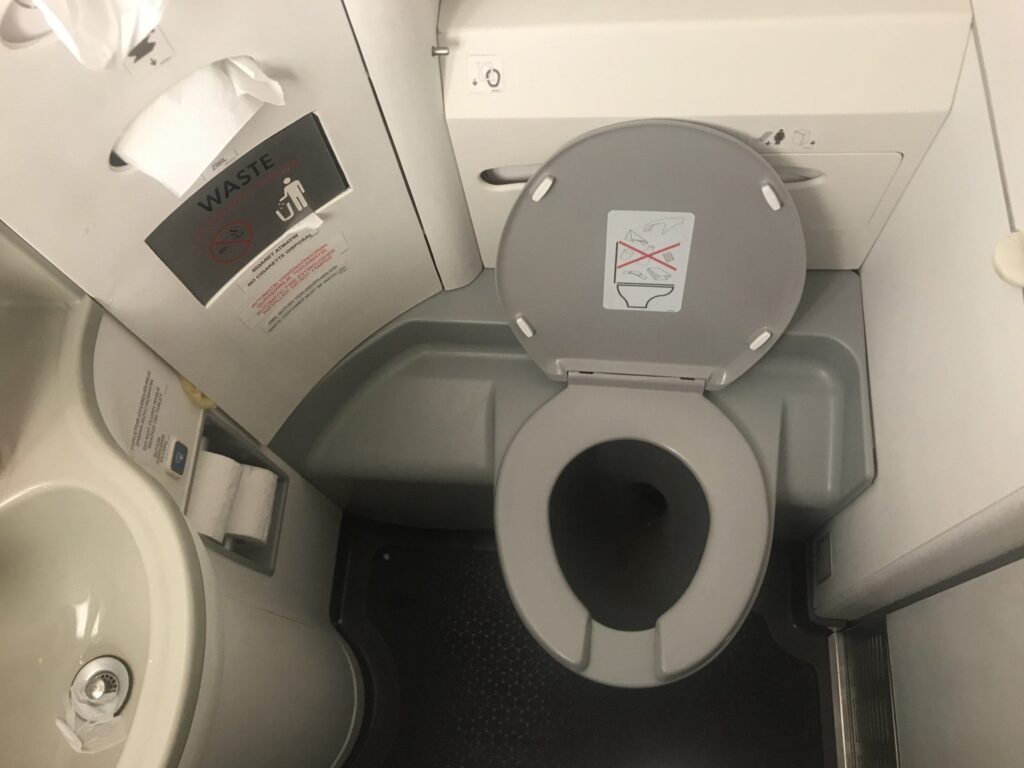
Twenty minutes after cruising altitude was reached, the aircraft began its descent. The engine noise diminished, and soon we were flying over green fields, rocky hills, and, as we neared the Caspian Sea, sandier landscapes. Shortly after the descent began, the crew made an announcement to prepare for landing. As we flew over the coast, the aircraft turned back toward land and aligned for an approach to Runway 16. Luxurious villas and beach resorts near Bilgah and Nardaran came into view as the Embraer gently descended and touched down at 1440.
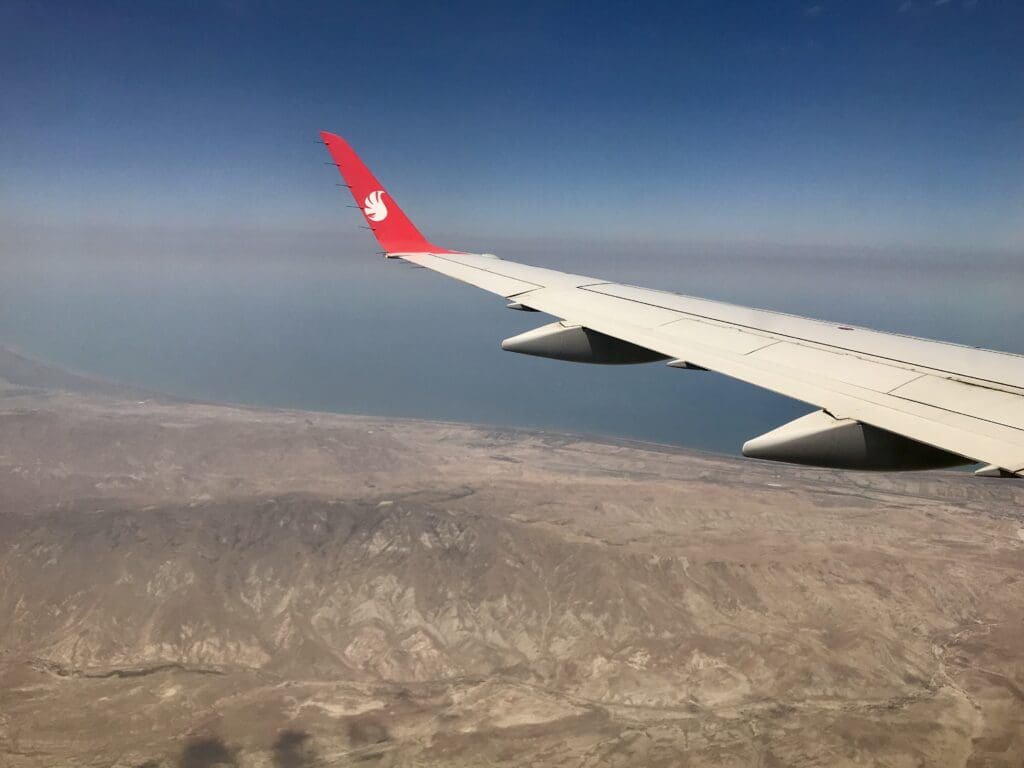
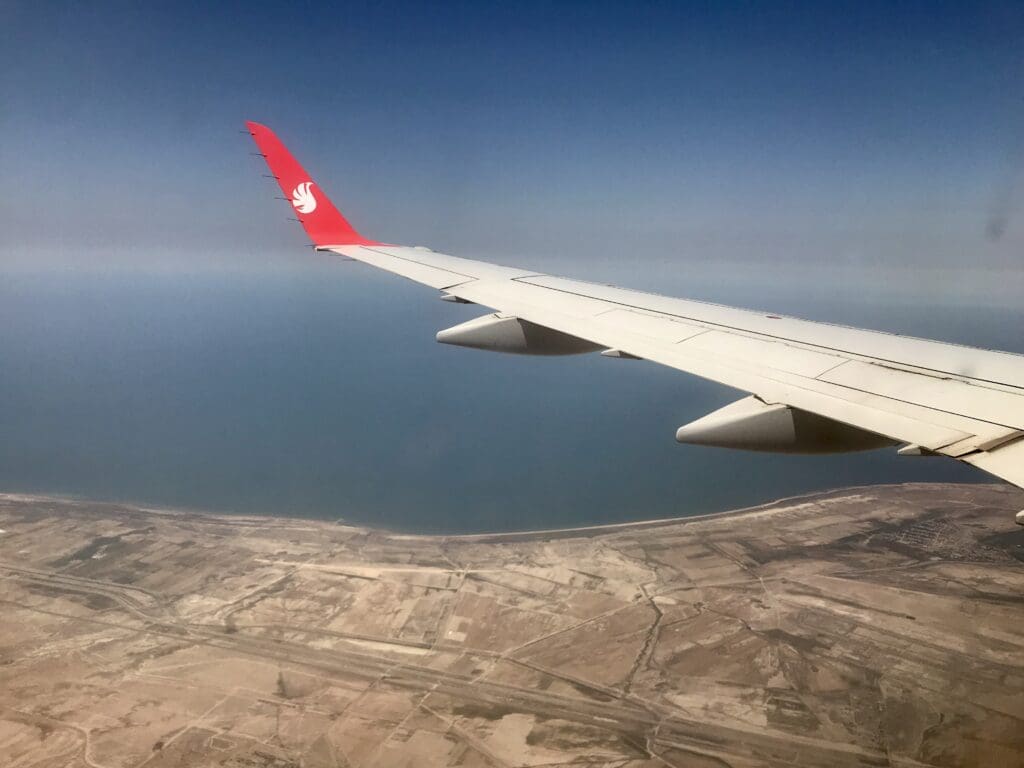
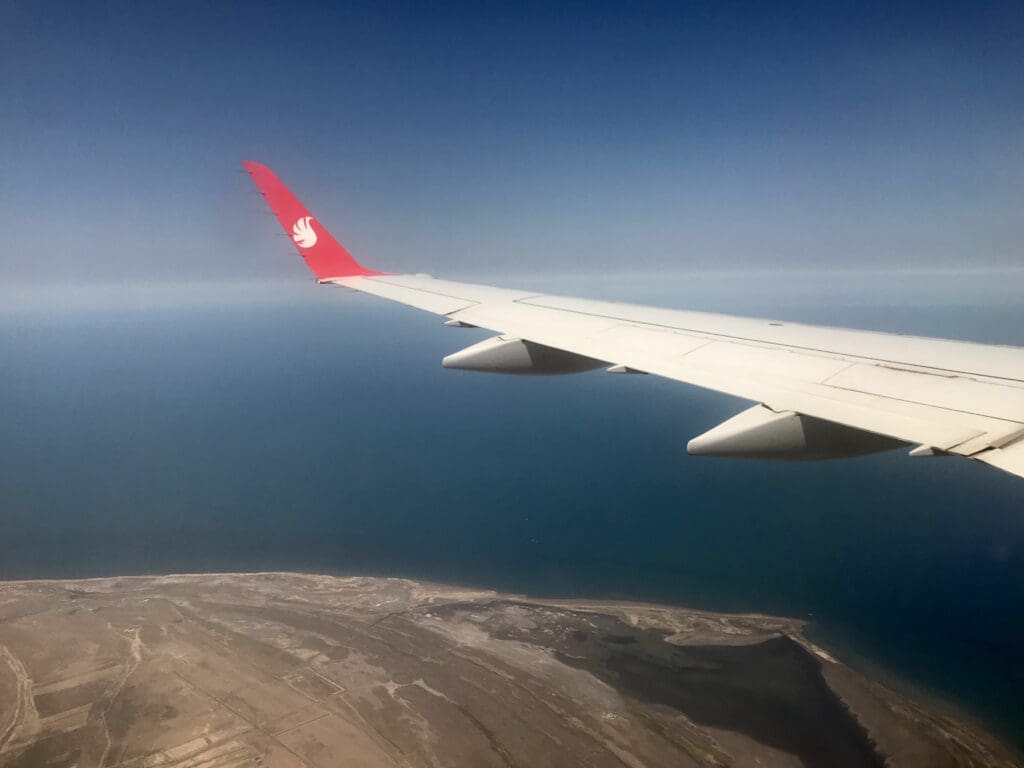
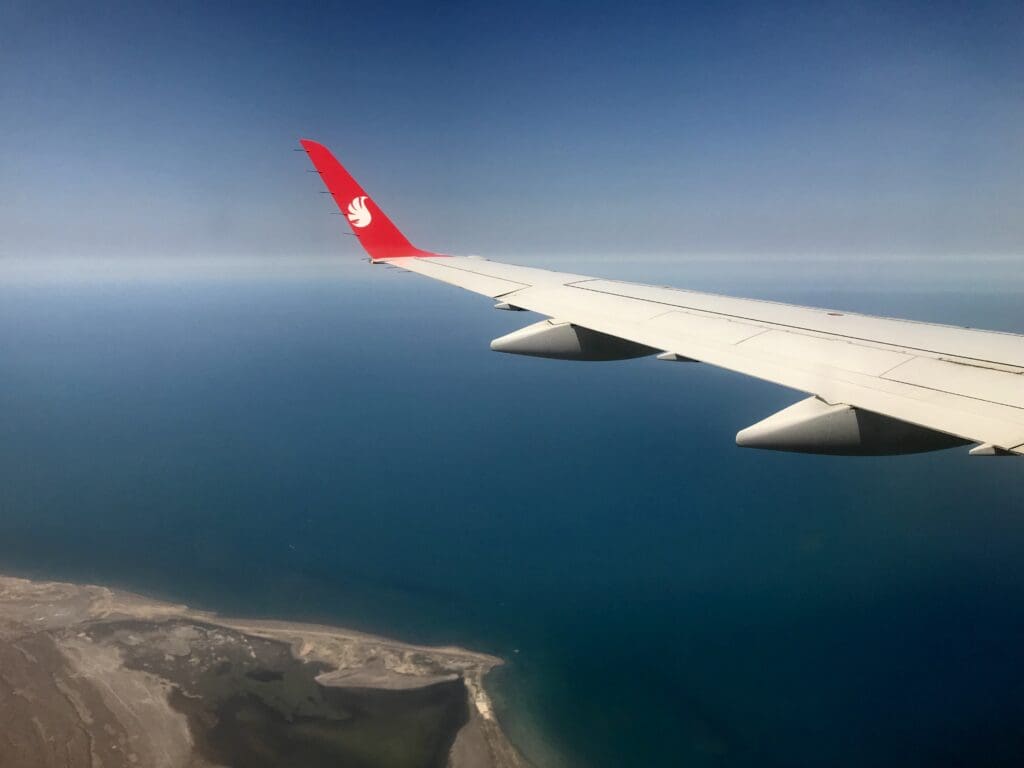
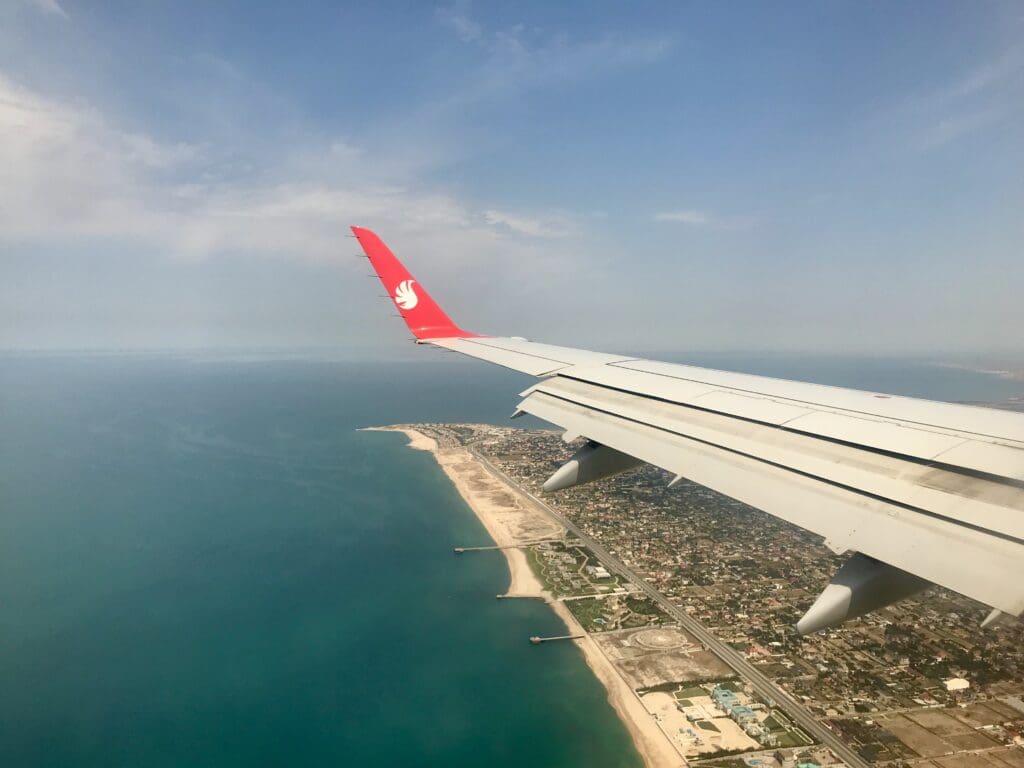
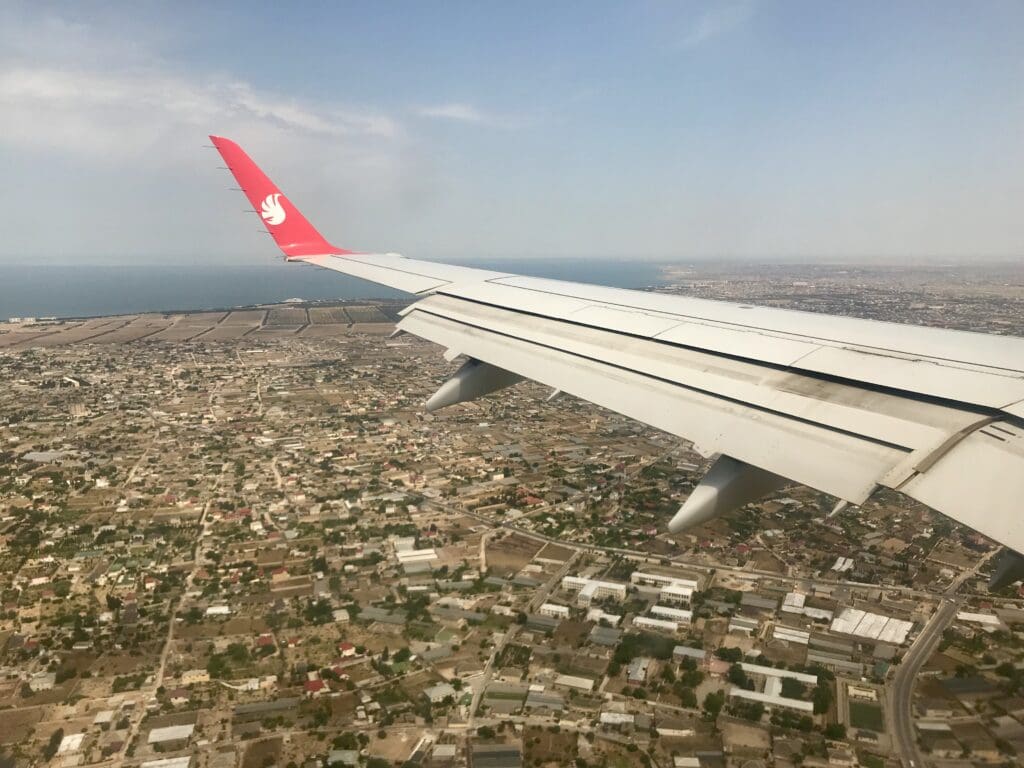
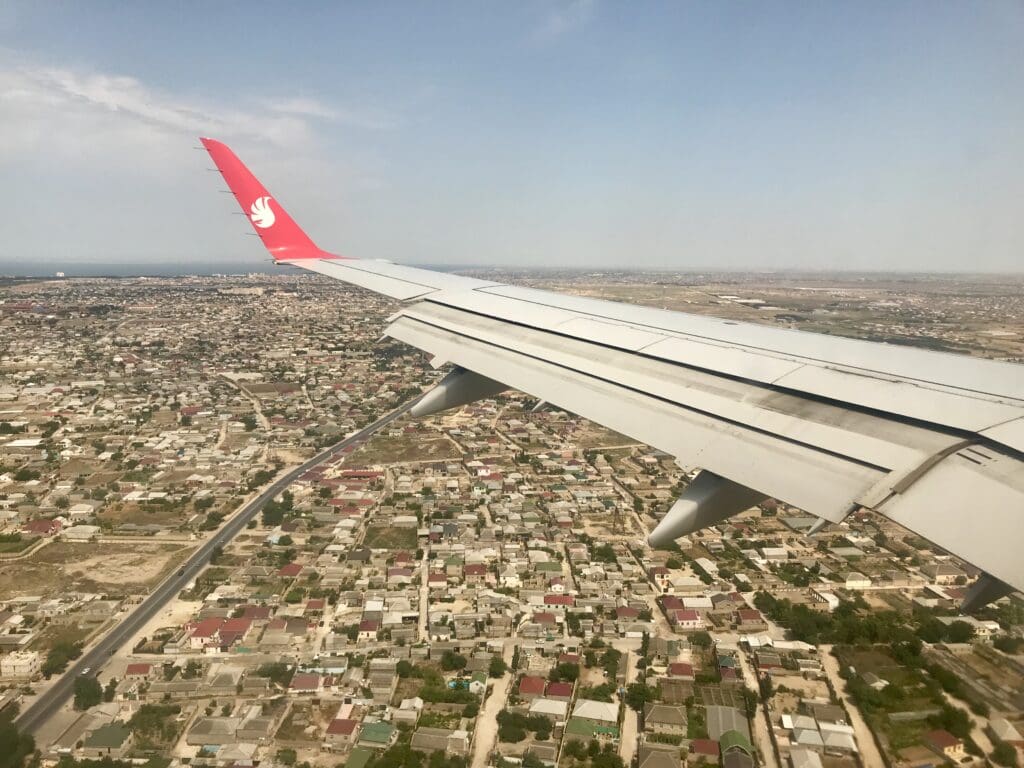
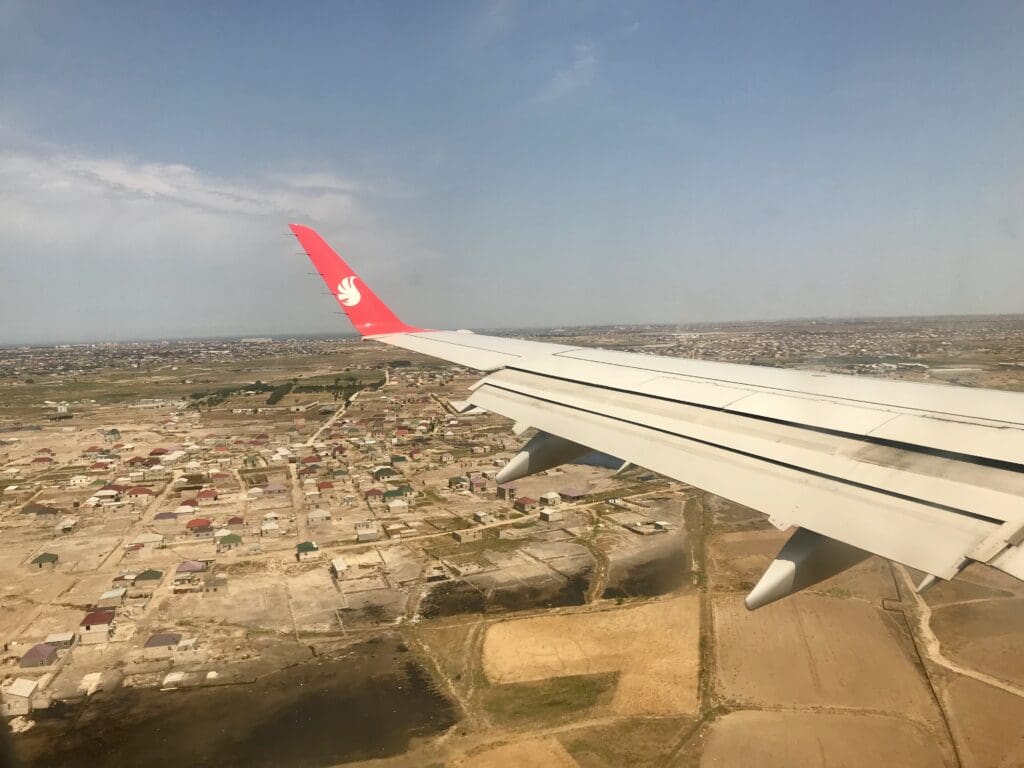
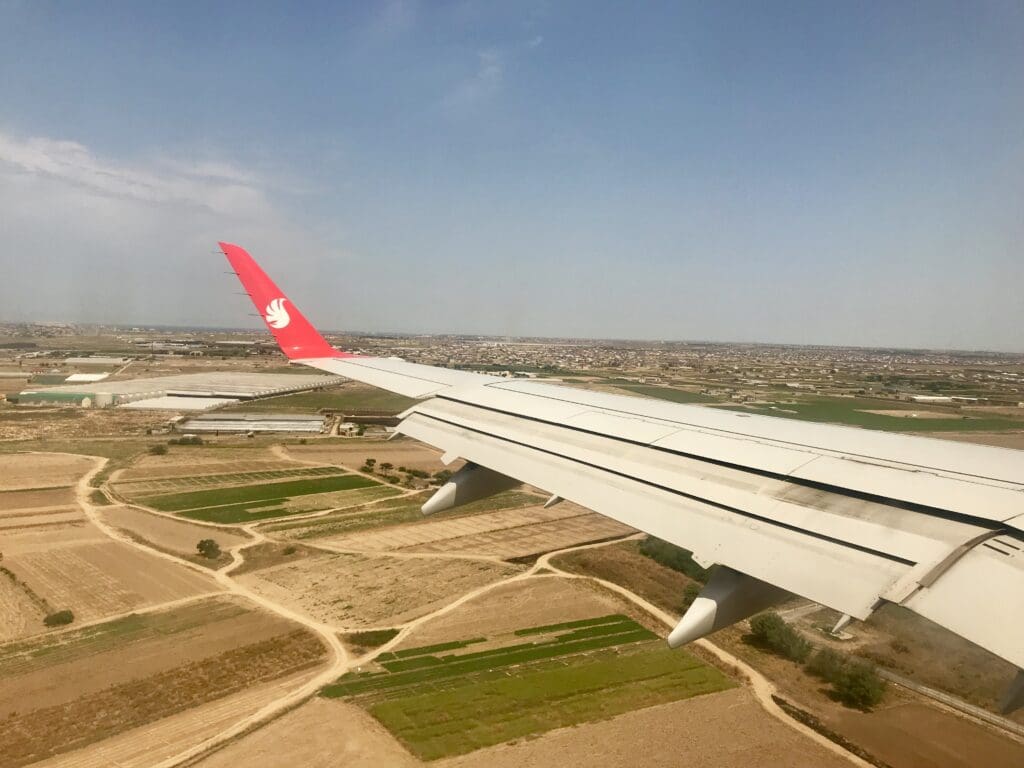
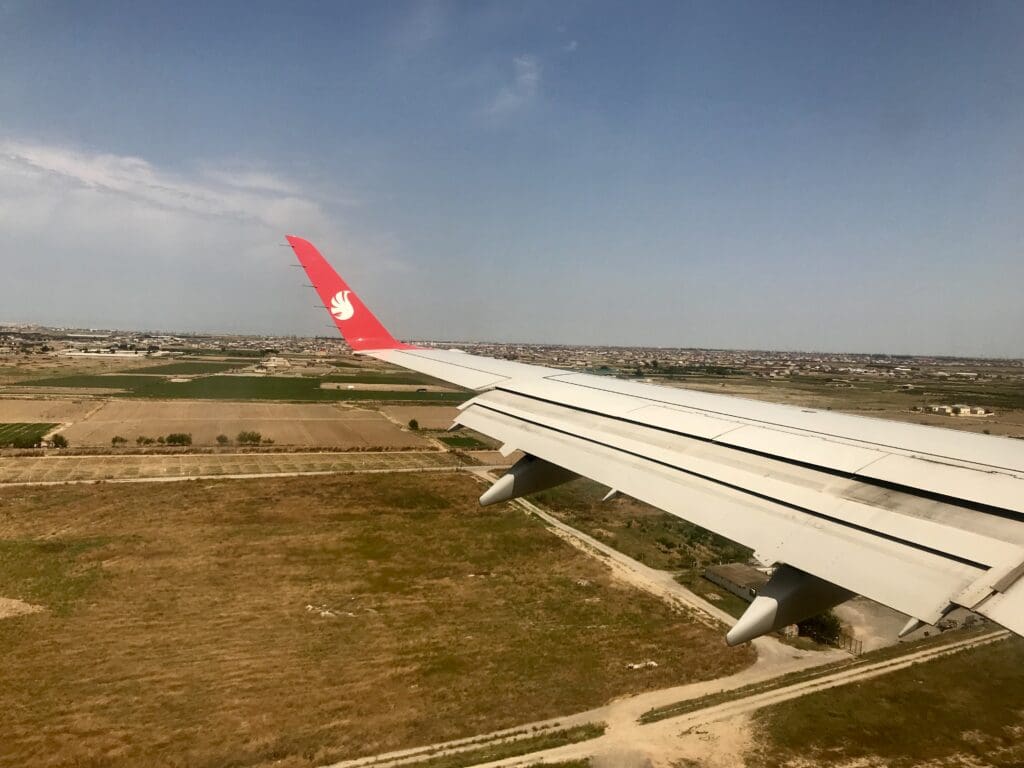
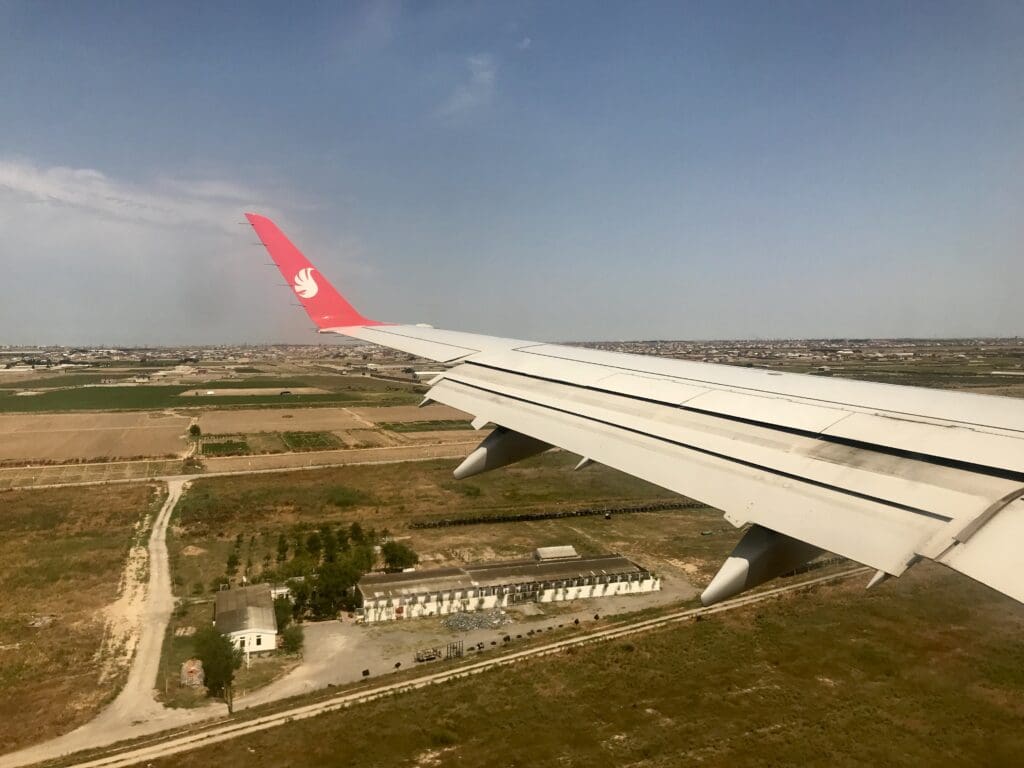
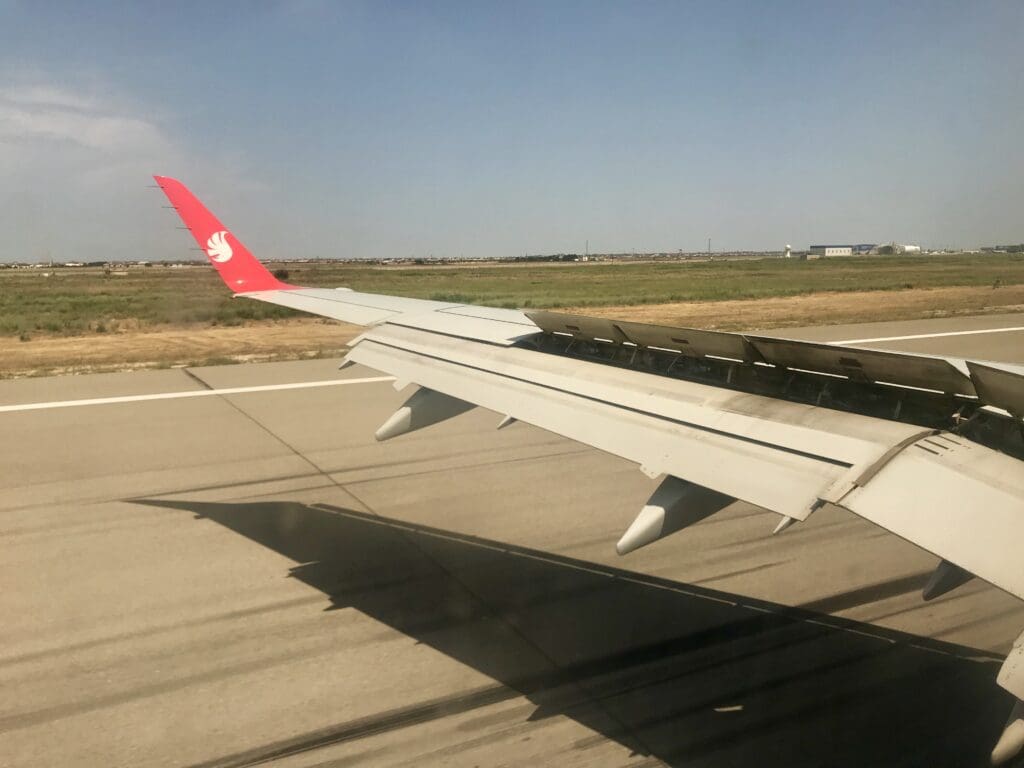
After a smooth deceleration, the aircraft turned off the runway and taxied to a remote stand. The purser made a post-arrival announcement welcoming passengers to Azerbaijan and thanking us for flying with Buta Airways. While taxiing, we passed an IrAero Sukhoi Superjet that had just arrived from Krasnoyarsk. The aircraft then parked at stand A14, next to another Buta Airways Embraer 170 that had flown in from Gazipasa, Turkey. Once we came to a halt, there was a brief silence before passengers stood up in a rush to exit. Thankfully, disembarkation began shortly after, and I thanked the crew as I exited the aircraft.
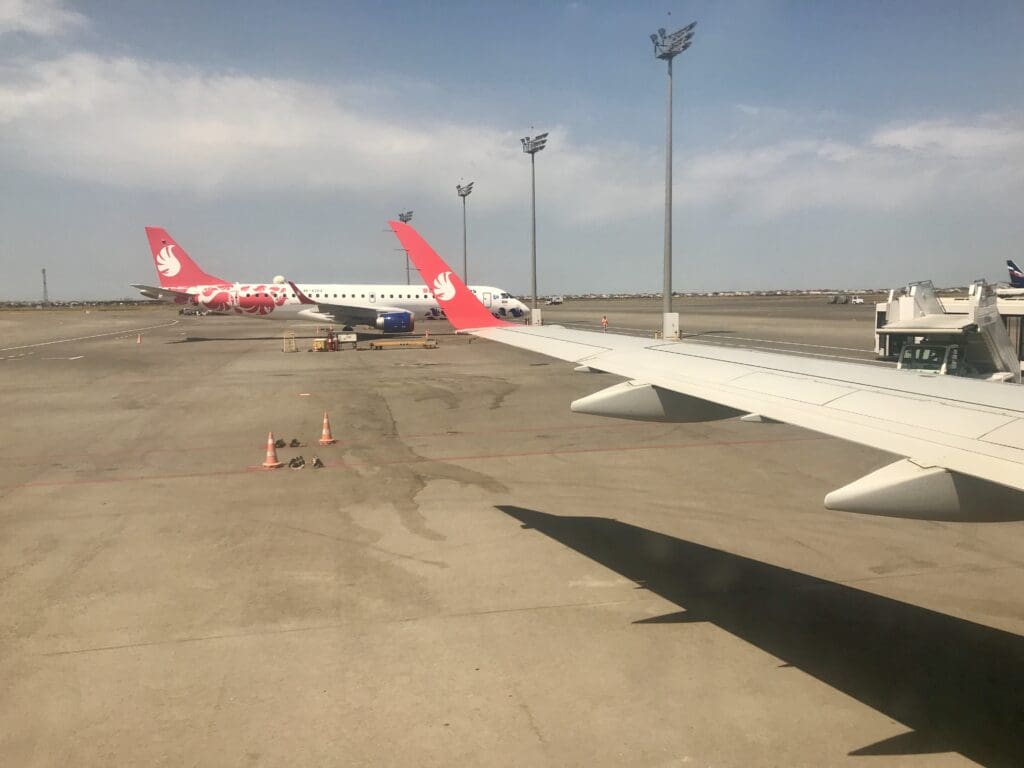
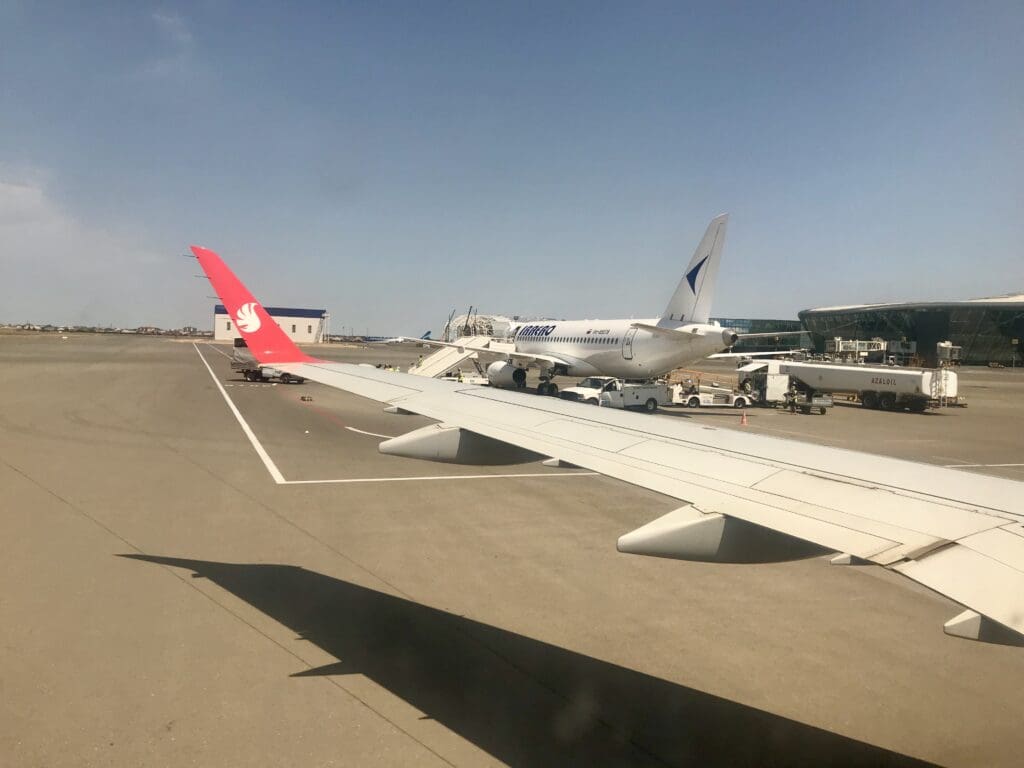
Stepping off into the hot summer sun, I entered a crowded but cool air-conditioned bus, which soon made its way to Baku’s luxurious terminal. Along the way, we passed a vintage Boeing 737-400 operated by Jordan Aviation, preparing for its journey to Erbil. After a short walk from the bus, I arrived at immigration. Since our flight was the only international arrival at the time, the queue was short. I handed over my passport and e-visa, which were quickly returned, and I was free to enter Azerbaijan.
Summary
Unfortunately, my experience with Buta Airways was marred by a long, unexplained delay at the start of the journey. However, aside from the initial hiccups, the crew was generally friendly, the aircraft was comfortable, and the complimentary offering was appreciated on this short flight. While I would likely avoid Buta Airways for longer flights, I would consider flying with them again on shorter routes like domestic services or their short hop to Tbilisi.

